BigJimFish
October 7, 2024
Desk of Contents:– Introduction– Unboxing,Look, and Really feel– Navigating the Binoculars– Optical Efficiency– Laser Efficiency– Different Onboard Sensors– The Smartphone App(s)– Vary Enhancers and different aftermarket equipment– Abstract and Conclusion– Background on Ballistics Calculation, Modeling, and Utilized Ballistics Elite– Background on How Laser Rangefinders Work– Background on the Challenges of Getting Optical Efficiency from a LRF Bino– Background GPS Mapping with BaseMap:
Introduction:
Safran is a big army / aerospace firm greatest identified in precision rifle circles for its army electro-optics merchandise marketed beneath the commerce title Vectronix. Regardless of being initially solely bought to army and LEO, many of those merchandise had been nonetheless civilian authorized and have become fashionable on the secondary market. Crucial amongst these was in all probability the unique Vectronix Terrapin that for years was the undisputed greatest laser rangefinder an individual may get for considerably lower than the worth of a automotive. Maybe due to this sudden reputation on the secondary market, Vectronix dipped its toe into the civilian market with the Terrapin X in 2018. The Terrapin X was one thing of a trial balloon as they contracted it’s manufacture from Leica and subsequently didn’t need to threat increasing manufacturing skills with a purpose to take a look at the potential of the civilian marketplace for their merchandise. The Terrapin X had successes and satisfied Safran to create a business enterprise unit throughout the firm beneath their well-known Vectronix branding devoted to business merchandise for lengthy vary shooters and hunters. These Vector X laser rangefinding binoculars and the Radical X sister product that’s the identical binocular with out the rangefinder are the primary merchandise of that new division.
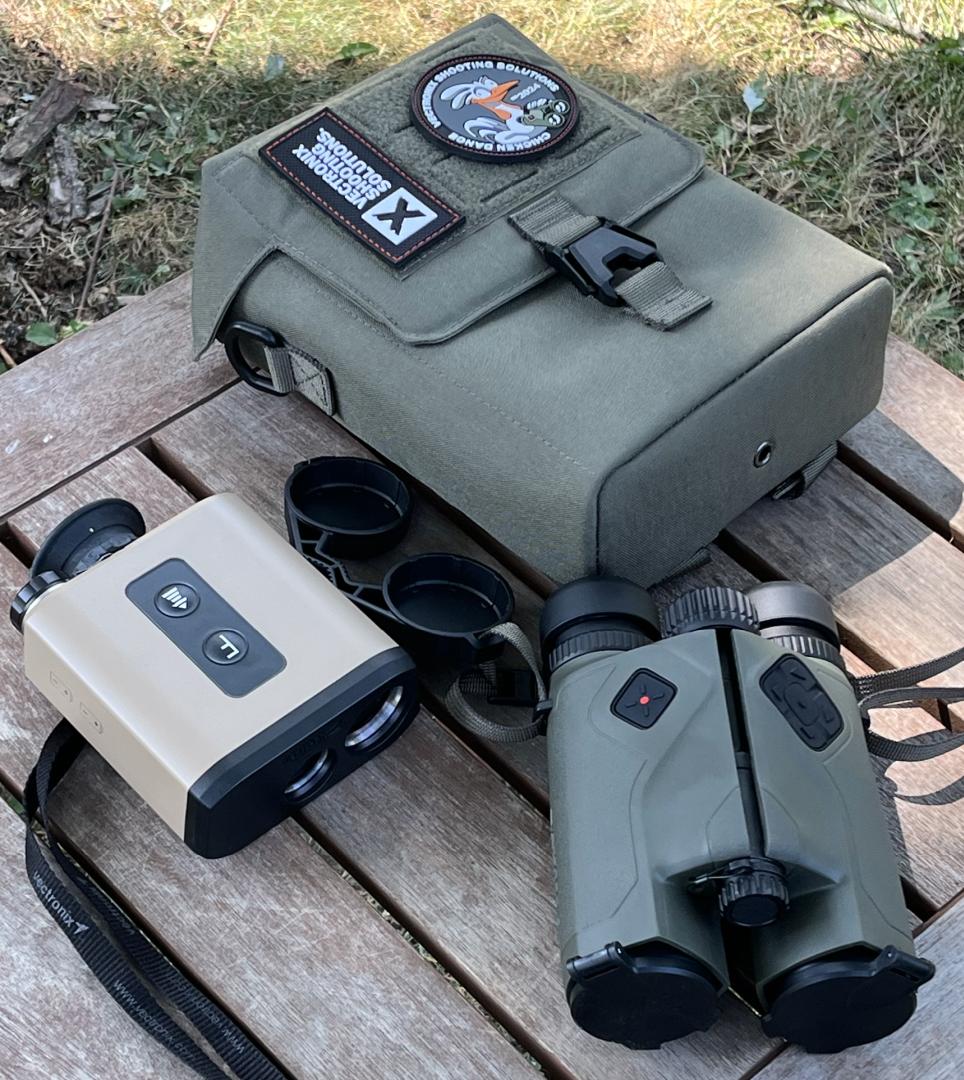
A couple of months in the past, the Vectronix of us reached out to Frank and I. They had been fascinated by having us evaluate the Vector X binoculars on the conceal. Given all of the work I had lately finished with the Leica Geovid professional and Sig 10k evaluations in addition to Franks work with the Terrapin X and the EveryDaySniper podcast on electro optics and utilized ballistics we did collectively, this seemed to be an ideal match. Throughout out assembly with Philip, the product supervisor the brand new business enterprise unit, I used to be struck with how a lot work Vectronix had put into understanding particular rangefinding use circumstances and workflow each for aggressive shooters and for hunters. They’ve designed the Vector X’s with some attention-grabbing options to beat a number of the commerce offs normally confronted when attempting to serve considerably completely different buyer use circumstances. Notable options on the Vector X binos are, high tier glass aggressive with Leica Geovid Professionals, Utilized Ballistics Elite in-built, distinctive connectivity to different digital gadgets, an etched reticle and screw in magnification boosters for recognizing scope substitute, a tripod mounting level on the barrel, CR123 or 18650 battery choices, an AMOLED display and D-Pad interface, and a ranging engine aggressive with the Sig 10ks.
Unboxing, Look, and Really feel:
Though I knew I’d be receiving quite a few optionally available equipment similtaneously the evaluate pair of Vector X binoculars I used to be stunned to seek out these extras wrapped up in a shiny media bundle all properly packaged and with a shiny product information. I felt like a tech business reviewer for a day as that form of product roll out is frequent within the a lot bigger tech business however fairly uncommon within the out of doors sports activities world. What was included on this package deal was, with all retail packaging and equipment, a 10x set of Vector X late stage engineering pattern binoculars, the vary enhancers (thread on 40% magnification boosters), threaded Tenebraex mixture ARD and flip caps, an Space 419 arca mount, an RRS arca mount, a shiny informational brochure, a really good case, and a rooster dance patch.
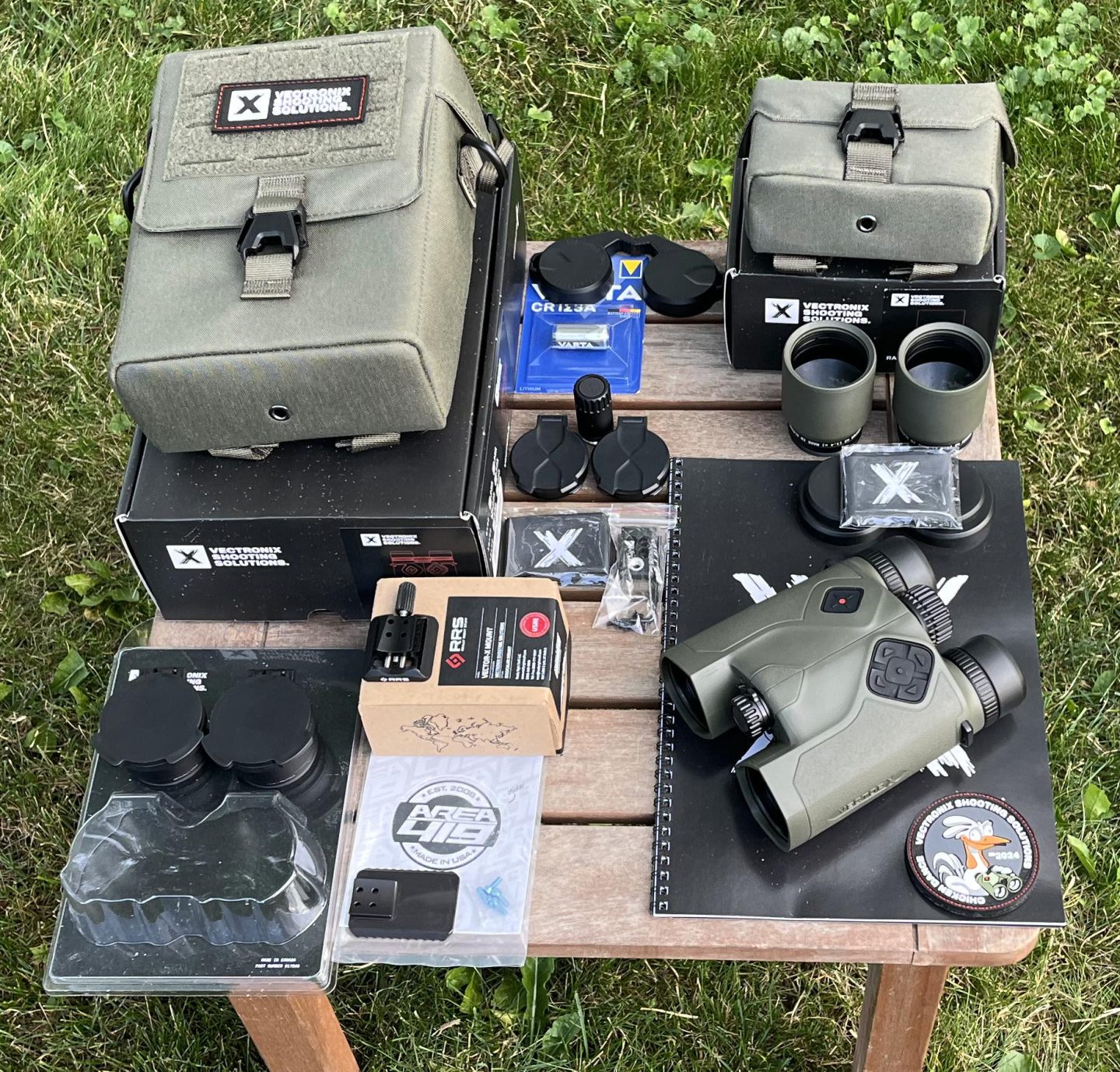
I feel it’s greatest if I cowl the aftermarket equipment in their very own part and persist with the binoculars and their included equipment right here. The included equipment the Vector X comes with embody, flip caps, an prolonged batter cap to permit for rechargeable 18650 battery use along with the CR123 battery and cap it comes with, a lens material, rubber eyepiece protectors, a ¼” x 20 tripod adapter, and a carry case and strap. Vectronix clearly spent a while and thought on these equipment and quite a few them are price declaring some options on.
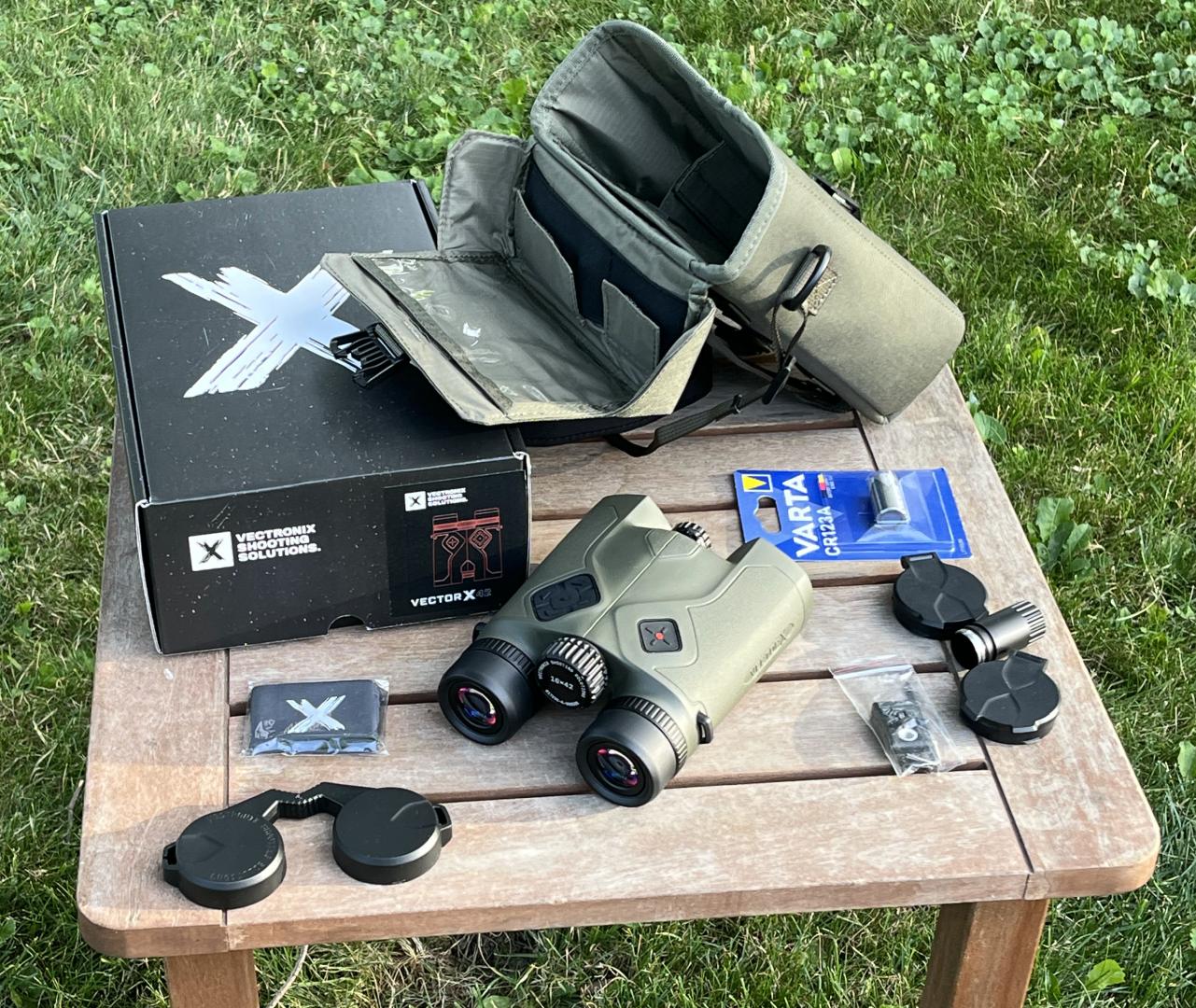
The case included with the Vector X binos is a really prime quality and constructed from heavy obligation, evenly padded, nylon. It has Velcro MOLLE loops on the entrance flap and MOLLE loops and webbing on the again. The entrance panel MOLLE suits the magazine boosters if you happen to purchase them and are so inclined to connect them there. The rear is clearly designed to connect the case to a backpack. The binocular case closes using a clasp in entrance permitting you to correctly safe the case with the strap connected to the binos however fed out although all sides of the case flap in order that it may be used to hold the case and binos collectively. The case additionally options attachment factors for a strap on its sides. The case itself could be very giant and clearly designed to carry a number of additional equipment. As an illustration, it’s deep sufficient to suit the binos with the Tenebraex ARDs on them. It could possibly even match the magazine boosters although that may be a tighter match than you’ll in all probability need and would encourage you to depart them connected. I don’t suggest this because the useless air house that creates may foster mould development between the 2 if you happen to change environments similar to going from a scorching soupy day exterior to placing the binos in a cool secure in an air conditioned home. Trapping moisture is a foul factor. The case additionally has an extended skinny inside slot on the facet designed to suit a Kestrel. Different pockets embody a big doc pocket behind the binos, a transparent pocket on the flap for becoming a map or DOPE card. The case has additional been designed to function a show stand for this DOPE card even within the wind by having Velcro on the highest that interfaces with a strip on the facet to carry the flap open and vertical with a purpose to show the DOPE card. The case additionally has a small pocket on the highest within the lid with loops for batteries. I don’t love battery storage instantly above the ocular lenses, however vectronix has included a rubber ocular lens cowl that ought to stop any injury if used.
Talking of batteries, the Vector X makes use of a CR123 battery as a substitute of the extra typical CR2. This can final 1.5-2x longer per battery however be sure you purchase high quality batteries such because the German Varta included. Along with dimension, a part of the rationale rangefinders normally use CR2s is that there are fewer low high quality makers of that picture battery than of the CR123 batteries most frequently utilized in flashlights. Purchase good batteries to your rangefinder, not the most cost effective junk you could find. That goes for any batteries and any rangefinder however Vectronix truly mentions it of their handbook in addition to a advisable battery model listing although, I used to be unable to seek out that listing on their web site. Uniquely, the Vector Xs truly include a second, prolonged cap to be used with a chargeable 18650 battery. Each of those caps can connect to the binos with a bit army type retainer leash.
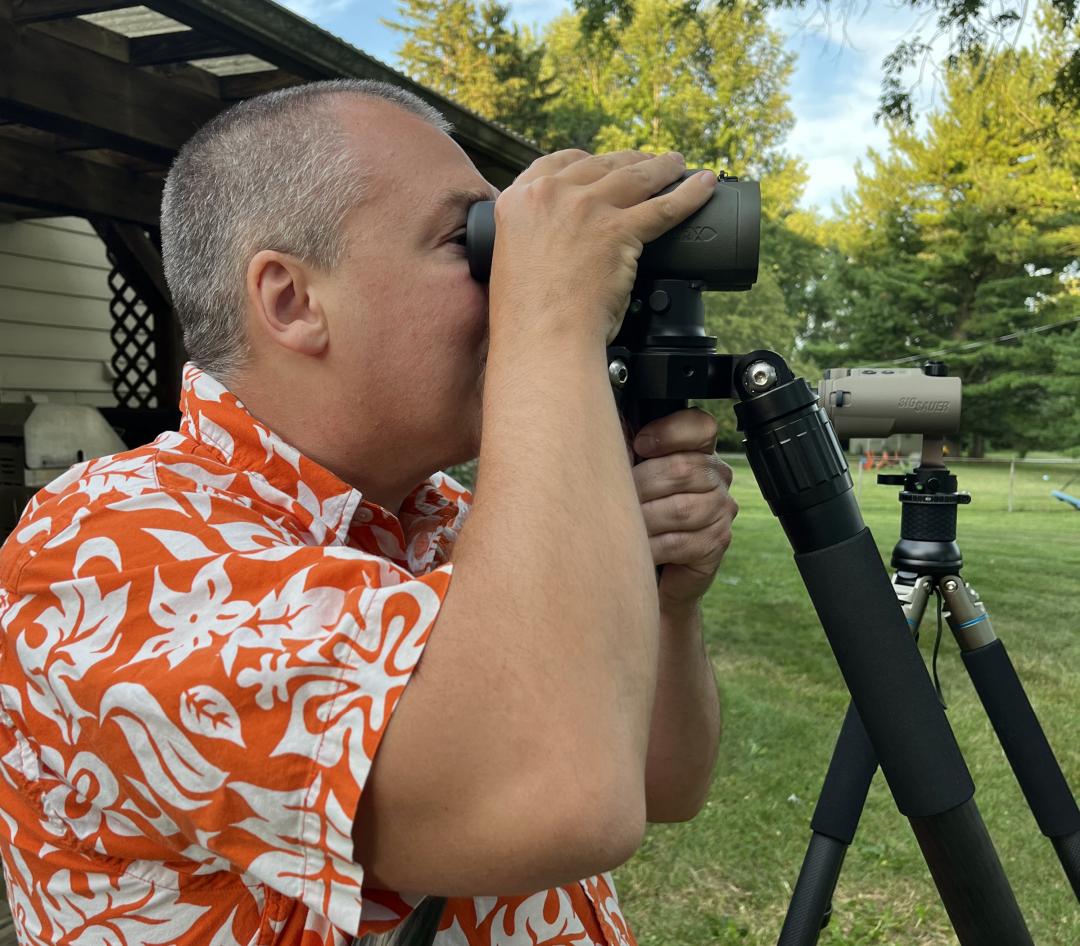
One other distinctive attachment the Vector X and their sibling Radical X binos have is a in-built attachment level on the underside of the appropriate barrel for a tripod mount. Each binos, with their etched reticles and accessible magnification boosters, are supposed to have the ability to be used as a recognizing scope substitute. This attachment level is designed to offer for a extra stable tripod attachment then the assorted bridge mounting tripod adapters many manufacturers use. Included with the binoculars is a small and primary ¼” x 20 feminine adapter that can match the binos to many picture tripod heads. Aftermarket, ARCA adapters will be bought that match the binos to extra strong picture heads or taking pictures tripods. These mounts are very stable and efficient, do watch out although as you possibly can apply loads of drive to the binoculars most important tube with them and I anticipate not less than one particular person will rip a bit off their tube off as a result of they’re utilizing the binoculars as a lever to maneuver round a stout taking pictures tripod head with means an excessive amount of resistance.
The final accent to say is the flip caps. These slot in a groove contained in the rubber armor in entrance of the target. They are often rotated 360 levels and have the hinge positioned such that the open cap can lay again flat towards the binoculars tube. It’s a pleasant thought, however in apply, the caps like to catch on the case when the binoculars are being extracted. They like to do that proper on the finish in order that they typically have a bit velocity as they fly off. In brief, they’re higher than those the Geovids have however no match for the built-in design Swarovski NLs have or for those built-in within the aftermarket Tenebraex ARD gadgets.
The binoculars themselves are what I’d name a form of subdued inexperienced mossy oak colour although Vectronix calls it TAC grey. They weigh in at 34oz and are a bit longer and thinner than Sig 10ks or Vortex Fury HD 5000s. The attain to the buttons is a little more small hand pleasant than 10ks however these are nonetheless not open body birdwatching type binos just like the Geovid professional they usually really feel much more blocky and fewer snug. This isn’t helped by the ARCA plate you’re possible going to completely affix to the underside of the appropriate tube. The mount is price it although, particularly in case your going to make the most of the Vector Xs as a recognizing scope substitute. Simply don’t anticipate the binos to be tremendous cozy for one hand use with a mount on them. Like just about any binos lately, the Vector X’s function multi place twist up eye cups and these are properly sized for snug use. As with different rangefinders there’s each a proper and left diopter adjustment. These changes are suitably tremendous stiff and are literally anodized aluminum as a substitute of getting some rubberized coating. Likewise, the main focus knob can be anodized aluminum and is giant in dimension with giant knurling designed to proceed to perform effectively with a gloved hand. The main target could be very straightforward to maneuver and has a fairly perceptible lash within the instance that I’ve. That lash within the focus knob is the one facet of my examination of those binoculars that doesn’t seem high quality. The battery cap on the Vector X’s is within the entrance of the bridge and is sort of straightforward to take away and change with out instruments and with out cross threading it.
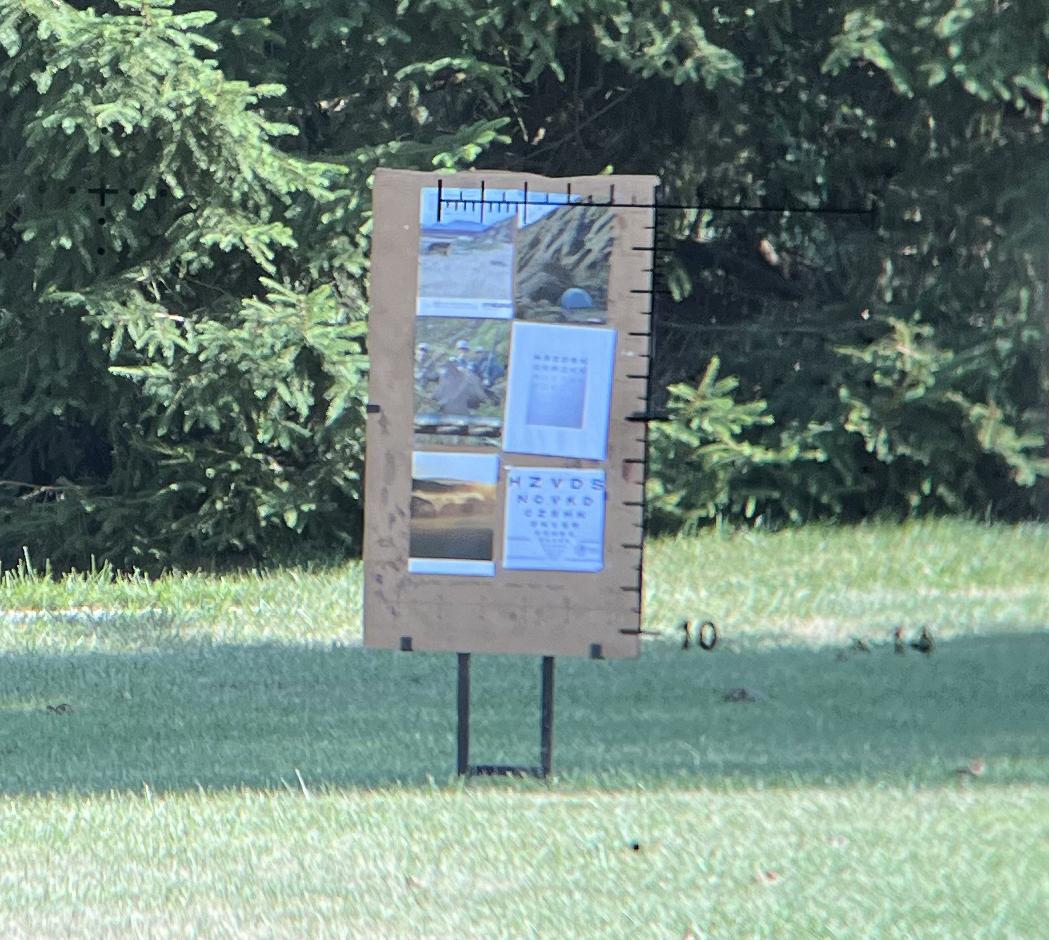
Earlier than I depart the appear and feel of the Vector X binos I’ll discuss concerning the etched glass reticle as this is without doubt one of the major options that units the Vector X and their sister Radical X binoculars aside from their opponents. Few laser rangefinders and even fewer stand-alone binoculars have etched glass reticles designed for recognizing photographs. The usage of excessive powered binoculars in recognizing photographs instead of a recognizing scope has change into rather more fashionable amongst aggressive shooters lately as having each eyes on the shot is tremendously useful in recognizing hint. Present considering is that two eyes at considerably decrease magnification is the most effective answer for recognizing photographs. The Vector and Radical X binos with the magazine boosters are available at 14x for the 10x mannequin and 17x for the 12x mannequin placing them proper within the energy vary present considering is gravitating in the direction of. There are two primary reticle sorts accessible in these binos with each designed by the fellows at FinnAccuracy who even acquired some notes from our personal Frank Galli on the unique drafts. FinnAccuracy are well-known for his or her design of the MSR reticle in S&B and quite a lot of different scopes. The binocular reticles are the SMR and DMR and they’re designed for single or twin magnification vary respectively. The SMR is a straightforward graduated L twords the underside left of the sector of view. It’s designed for use solely with the binoculars’ base magnification with no magazine boosters put in and is good for offering an unobstructed view for a person who solely often intends to make use of the milling capabilities of the reticle a lot and needs it as unobtrusive as attainable. This is able to possible be for utilizing the Vector X or Radical X binos as looking binos with no intention of utilizing them on a tripod with magazine boosters to identify photographs and name corrections. The DMR reticle is definitely two reticles. On the appropriate is a T- formed reticle graduated to be used with the magazine boosters and on the left is similar reticle graduated to be used with out. The respective reticles are labeled with the magnification they’re calibrated for. Each of those T formed reticles even have a discipline of 1 mil separated dots to the surface of their central submit. I very very like the idea of this DMR reticle and once I examined it, I additionally discovered it sized inside 1% of right which is excellent. After some use although I feel some enchancment might be made to the execution. For my part, the considering on the commencement of those reticles owes an excessive amount of to rifle scope considering. Binoculars, even on a tripod, are simply not as regular as a scope on a well-supported rifle. These reticles actually don’t want finer than 1 mil graduations. Additionally, the 10mil label on the x axis could also be ten mills from the opposite finish of the graduations, however it’s 5 mils from the middle of the T. Labeling it 5 as a substitute of 10 can be extra intuitive. Lastly, it’s a little unlucky that space of the show doesn’t overlap with the laser intention level of the reticle. If it did, that may have allowed for an illuminated projected reticle excessive of the etched one. This is able to be useful in low mild when the skinny black reticle turns into mainly invisible. It additionally would have allowed for the potential of person positive adjustment to the intention level of the illuminated projected reticle. Positive, that may make it not completely align with the etched one and that may look bizarre however it might be definitely worth the unusual look to have one reticle completely aligned.
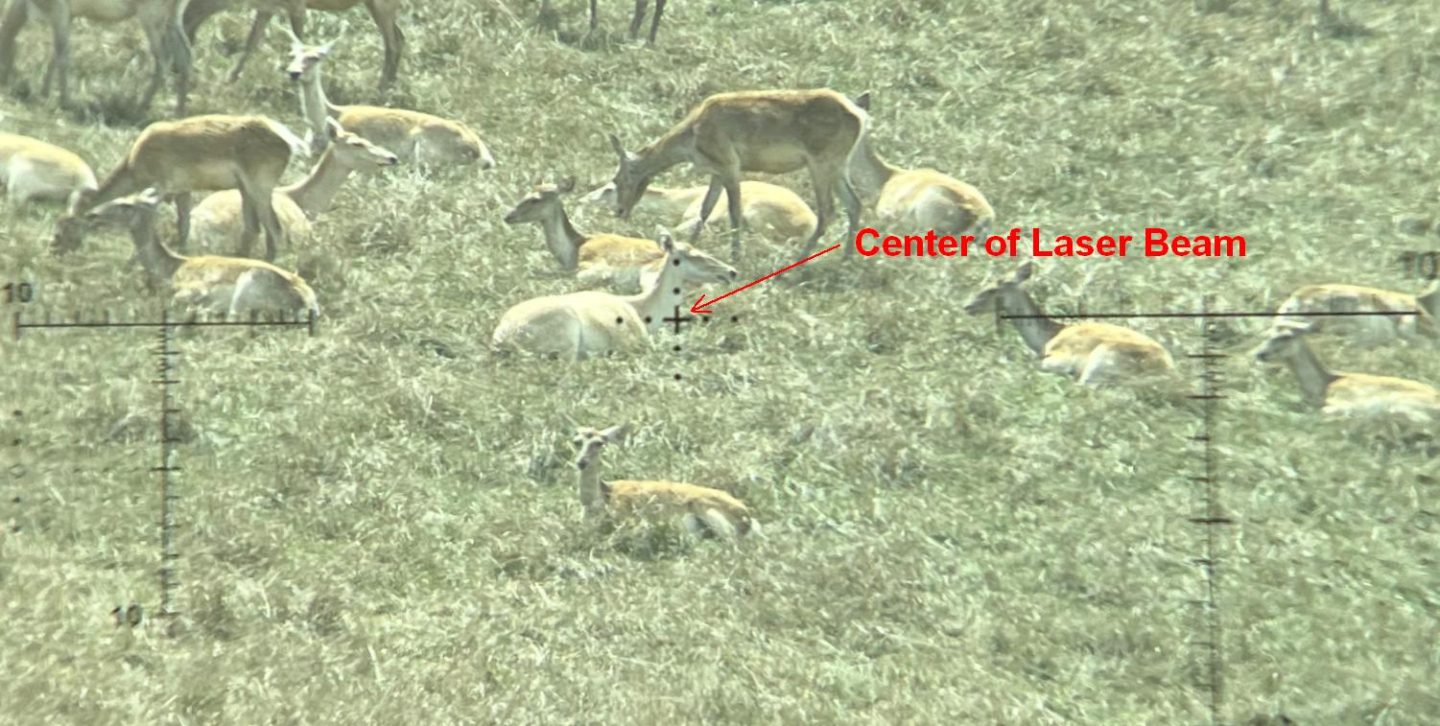
As with most laser rangefinders, there’s more likely to be some extent of deviation between the laser intention level and the reticle intention level on the Vector X binoculars and there’s no person mechanism to regulate this. Usually, laser rangefinder makers put the QC cutoff for this deviation at someplace round one mil although, I’ve no inside information of Vectronix particular QC requirements. As such, there’s usually substantial profit for the person in determining precisely the place his intention level is and making a word of it. That is greatest finished utilizing a sq. highway signal at about 200 yards. You vary to seek out the highest, backside, left, and proper edges of the signal and use this knowledge to find out the offset of your laser from the retcle. I then insert a bit card into my rangefinder case with a printout of the reticle with the intention level marked on it so I don’t overlook. Within the case of those take a look at binoculars, that true intention level is .5 mils proper and .2 excessive of the reticle heart, that is effectively throughout the possible QC requirements but additionally effectively price figuring out and adjusting to.
Navigating the Binoculars
As with different rangefinding binoculars, the Vector X’s have their show in the appropriate barrel solely. As with the Sig 10ks, this show is a 304 x 256 pixel AMOLED although it takes up a bigger space of the sector of view on the Vector X binos and consequently the textual content seems extra pixilated, contrasts much less with the remainder of the picture, and may take extra effort to learn in shiny circumstances. The brightness of the textual content on the Vector X can be not set routinely by an inside mild meter as on the 10ks and as a substitute is adjusted by the person utilizing quick presses of the ahead and backward arrows on the D-pad. Regardless of the big show space and numerous potentialities, the preliminary pre-measurement ranging HUD display on the Vector X is sort of missing. It shows the laser mode, bluetooth standing, and battery standing of the bino however the one piece of knowledge pertinent to the quickly to be calculated ballistic answer being proven is the compass heading and that isn’t even a really massive piece of that answer. Many of the display is simply wasted with clean strains the place the answer info will populate. Positive, on a number of subsequent ranges, this is perhaps crucial as you usually need your final studying to watch for a bit, however there isn’t a cause to only present clean knowledge earlier than a primary studying. Even the clean knowledge itself is frustrating, as I see no cause to have a bunch of crap blocking my discipline of view that isn’t telling me something. Ideally, I would really like this display to indicate the ballistic profile loaded, present wind setting, and present readings / settings for the DA, inclinometer, and temperature. I need to see this stuff earlier than I vary in order that I can do a final second verification that they’re close to right. Sig reveals most of those items of information on the 10k and I don’t see why they aren’t proven on the Vector X. For the submit ranging and ballistic calculation readout, Vectronix truly gives three screens that you may toggle between utilizing the left and proper D-pad keys. That’s nice, however with three screens they solely get you barely extra info than you get with only one on the Sig 10k. The first display shows the acquainted binocular standing panel, vary, elevation correction, two windage corrections, and compass heading. The second display reminds you what your windage was set to and provides time of flight and inclination. You too can rapidly alter the wind pace magnitude to your subsequent vary measurement from this display utilizing the up and down D-pad keys. The third display reminds you what ballistic profile you used and provides you the remaining velocity, and remaining power. I actually just like the double wind setting that you just get with the Vector X. It permits you to make a full windage bracket to characterize the vary of wind values you consider to be taking place and have that complete vary exhibited to you as a way to make your to-the-second estimate of the place you’re in that vary extra simply. In that respect, the first measurement display on the Vector X is nice. It provides you every little thing you want and nothing else. These secondary screens depart one thing to be desired although. They don’t re-hash what your atmospherics had been so you possibly can’t confirm that say your temperature isn’t means off since you forgot and left the temp on sensor and the binos at the moment are 105 levels within the solar. I just like the addition of time of flight and the speed and power readings are additionally nice however I feel max ordinance may be added. You could have two additional complete screens for this sort of info so actually nothing ought to be lacking and the vast majority of these two additional screens needn’t be dedicated to re-hashing the vary measurement from the first.
Vectronix has spent a great deal of effort and time in making an in-bino menu system that’s intuitive and thorough in addition to an interface to that system that’s quick for competitors use. The Vectronix Vector X handbook on-line goes via nearly the whole thing of this technique and I like to recommend it particularly to aggressive shooters who need to see precisely what the potential workflow will likely be as I understand how vital that may be. It’s a excellent and really thorough handbook. I’ll persist with the highlights and generalities right here so that this part doesn’t run to 10 pages of tedium. The handbook textual content itself is sadly not included within the app. Regardless of the huge capability of reminiscence our telephones now have, the app hyperlinks to the handbook although it’s menu system as a substitute of containing the handbook throughout the app. I don’t perceive why Vectronix and others do that. The handbook could also be wanted by individuals exterior of cell sign vary and takes an insignificant quantity of reminiscence to incorporate. By the way the web handbook linked is definitely a pdf. As such, you possibly can simply obtain it and put it aside to your telephone for accessibility offline. One thing I whole-heartedly suggest. It’s solely 7mb in English so, I assume it is going to price you about one picture price of storage capability to take action.
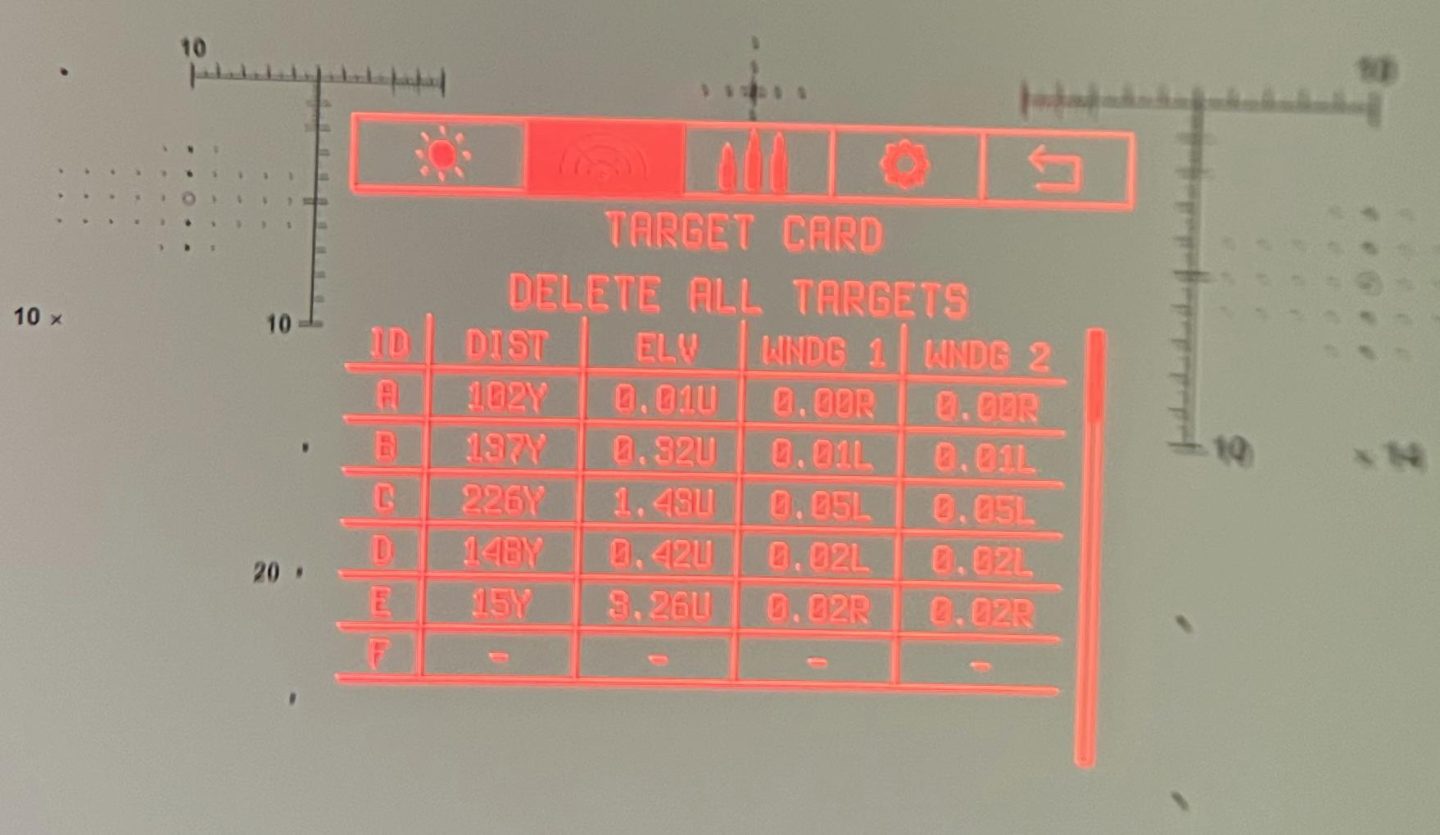
The Vector X in-bino menu truly makes use of its personal little GUI with icons for environmental, goal card, gun profile supervisor, and settings. These are very simply navigated utilizing the D-Pad buttons. A couple of highlights are how rapidly and simply you possibly can change the supply of environmental knowledge from the binocular sensors to manually entered or native climate station when it’s worthwhile to similar to when the binos are heating up within the solar and consequently present an misguided temperature. The Vector X binos even have the flexibility to create a reside goal card within the binos populated by truly ranging the targets utilizing the rangefinder and with out connecting to the app. That is finished utilizing one of many D-pad shorcuts activated from the principle HUD ranging display. These shortcuts are:
1) Fast faucet of the up and down keys -> Make show brighter or darker1.b) Fast faucet of up and down keys when particularly on HUD display 2 (the wind display) -> Change the magnitude of Wind 12) Fast faucet of the left and proper keys -> Cycle via the above talked about completely different HUD rangefinding screens3) Press and maintain of up key -> brings up a timer / stopwatch menu 4) Press and maintain down key -> brings up a laser mode change screen5) Press and maintain left arrow key -> brings up a bluetooth on / off menu 6) Press and maintain proper arrow key -> brings up the goal card creation by ranging menu
That’s loads of shortcuts and I feel match shooters and vary officers will definitely discover a bonus in a few of them. Vary officers at matches will now have a timer / stopwatch function possibility constructed into the binoculars they’re utilizing to identify. And opponents might discover aggressive benefit within the pace and ease with which you will get to and create goal playing cards utilizing the rangefinder. I perceive there additionally exists connectivity between the Vector X rangefinder perform and a number of the gun and wrist mounted shows that match shooters are utilizing such that the binos will obtain their knowledge on to these gadgets.
Optical Efficiency:
With out query, the optical efficiency of the Vector X was the largest shock of the evaluate for me. It’s not that they didn’t inform me it might be good, they did. All people says that although. Significantly, on nearly each optic I take a look at the advertising individuals inform me the glass is great and I’m going to be blown away. They are saying this with such conviction and, to be trustworthy, I don’t suppose they’re mendacity to me. I actually suppose they consider it. After all, most glass is common, that’s what common means. Common is what you’ve got probably the most of. Now, you may rightfully argue that common glass lately is basically good. That’s true. Nice glass in the present day shouldn’t be a complete lot completely different than nice glass twenty years in the past however common in the present day is an amazing quantity higher than common twenty years in the past. That being stated, common doesn’t blow anybody away since you see loads of common. Anyhow, the Vector X binos will not be common. They’re aggressive with the Leica Geovid Professionals that I reviewed two years in the past and that places them within the high teir for optical efficiency in LRF binos.

Particularly, I discovered the Vector X binos to have barely higher decision than the Leica Geovid Professional binos utilizing magnification compensated optical take a look at targets (my Geovid Professionals are 8x and Vector Xs 10x). Vector Xs additionally boast a considerably bigger discipline of view than the comparable Geovid Professional (10 x 42) mannequin and the Vector X and Geovid Professional have comparably wonderful dealing with of chromatic aberration. On the opposite facet of the coin, I discovered the Geovid professional to have higher colour rendition and barely higher edge-to-edge readability than the Vector X. This colour rendition distinction is as a result of stronger notch filter crucial for the AMOLED show within the Vector X vs. the segmented LED within the Geovid Professional. Whereas circumstances are very uncommon in which you’ll discover any blue tint within the Vector X binos in actual world use, you possibly can synthetically accomplish that by taking a look at a white wall with only one eye open and alternating wanting although the appropriate (has a notch filter), after which the left (doesn’t have a filter) barrel of the binoculars. You are able to do this with each the Vector X and the Geovid professional and you’ll discover that despite the fact that you don’t understand it in day-to-day use, the Vector X does have a considerably stronger notch filter than the Geovids. That is nessecarry for the AMOLED display to perform however the stronger the notch filter is the extra the colours seem extra muted and that’s the reason the Geovids colour rendition is superior. Neither the Vector X nor the Geovids seem to comprise discipline flatteners similar to are within the Swarovski EL vary and each present a comparable quantity of barrel distortion but additionally have the extra three-dimensional showing image attribute of binoculars with out discipline flatteners. All informed, the Vectronix Vector X and Leica Geovid break up vital optical measurement metrics fairly evenly and I really feel assured saying they roughly equal in total optical efficiency. This got here as fairly a shock to me as I contemplate the Geovid Professionals to be high tier in optical efficiency for a rangefinding binocular. Such efficiency from the Vector X is large and in addition bodes effectively for it’s non-rangefinding brother the Radical X that sports activities the identical optical design much less the notch filter.

Laser Efficiency:
The Vectronix Vector X sports activities a 905nm Class 1M “eyesafe” laser with 1.8x .1 mrad (8x and 10x) and 1.5 x .1 mrad (12x) beam divergence. It’s listed as having a 7,000 yard most vary on reflective targets, 3,000 yards on bushes, and a couple of,400 on deer. Its accuracy is listed as +-1m to 100m, +1 2m to 500m, and +- 5% over 500m. Vectronix lists an uncommon quantity of such technical specification in it’s handbook for these . Much like the Sig 10k binoculars, the Vector X is utilizing what I’d classify as a subsequent technology laser rangefinding engine. It’s not similar, however the identical ideas of extra knowledge factors unfold out over a bigger time-frame with extra time in between coupled with extra superior sign processing of the returned knowledge are being utilized.
One vital word earlier than we get into my take a look at knowledge and direct comparisons with the Sig 10ks and different rangefinders: The Vector X unit I’ve is a late stage engineering pattern with FPGA firmware that differs barely from the manufacturing variations now transport. The remainder of it’s firmware has additionally had quite a few updates all through the testing course of and these probably have, and can proceed to have, some impact on sign processing. As an illustration, the FPGA firmware within the Vector X unit I’ve processes noise heavy knowledge extra aggressively then the model being shipped. It thus delivers extra long-range readings in noise heavy inclement circumstances but additionally extra false readings in those self same circumstances. I’ll make clear this. Often, on longer ranges, roughly 2,000 yards or additional, in shiny and scorching circumstances, the unit I’ve will miss-interpret background radiation as sign and ship a false, and at all times additional than precise, distance studying. These phantom readings are at all times additional than the true distance and don’t seem constant from measurement to measurement. As such, if a number of ranges of the identical level are taken, they stick out as the large numbers who haven’t any twins whereas the proper vary will likely be smaller and have a number of readings registering close to similar distances. Manufacturing models will yield fewer of those phantom readings but additionally fewer of the true far distance readings beneath these troublesome circumstances. Chances are you’ll even by no means see such a phantom studying as I’ve not seen any with Sig 10k binoculars that use related knowledge processing. Throughout the first day that I did lengthy distance rangefinding, a very difficult day by way of circumstances, these phantom readings had been comparatively frequent. They had been maybe one in 5 readings for targets over 2,000 yards. With every software program replace for the Vector X, they’ve change into much less frequent to the purpose that I had just one on my final ranging journey so I anticipate that you will note few or none. On the opposite facet of the coin, I’ve not seen an amazing discount within the ranging functionality that I’m seeing and the entire vary generalities I will likely be relating are true of the most recent software program iteration although nonetheless with the unchangeable prototype FPGA model that I’ve.
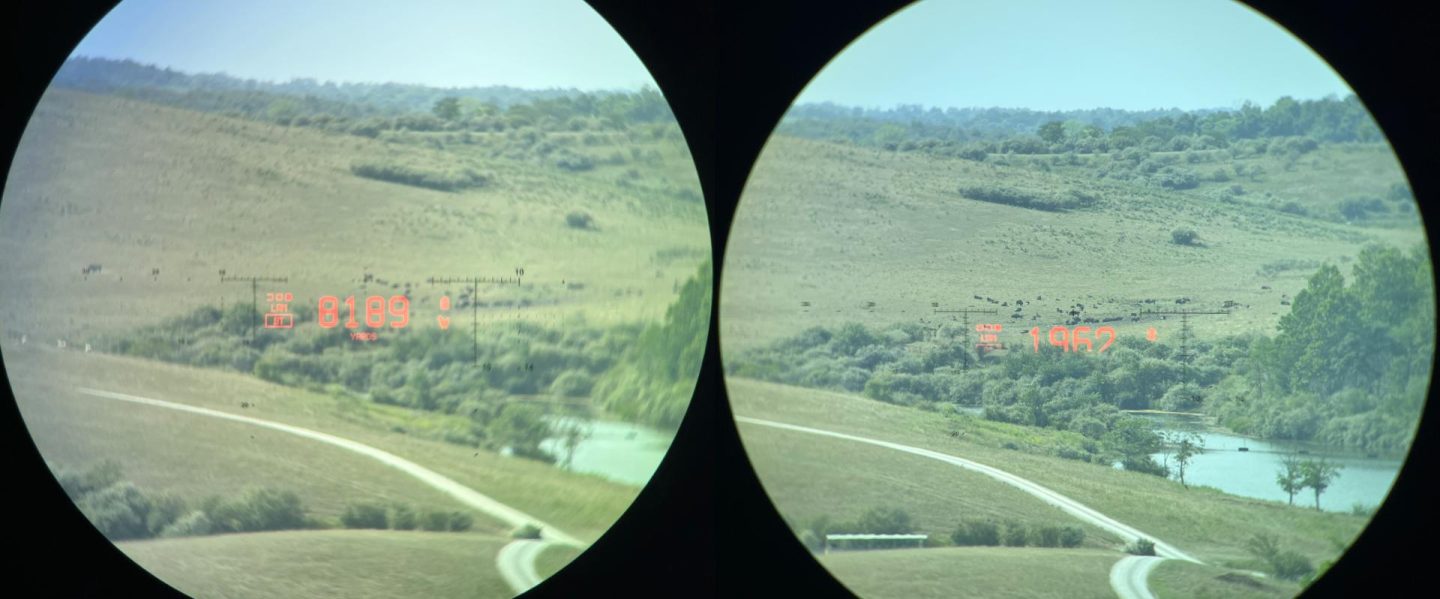
Now for some precise efficiency numbers and comparisons with the Sig 10ks and Leica Geovid Professional 32s. Vectronix claims 7,000 yards for a most reflective goal vary. I’ve hit 6,405 on a bridge on a shiny sunny day. I used to be unable to duplicate that on both technology of 10k binoculars on the identical day and, in truth, I’ve by no means been in a position to vary that bridge with the 10k’s although I’ve been attempting with the primary technology pair for a pair years and have made makes an attempt with some on cooler overcast days that had been simpler ranging circumstances. After all, the Geovids seem to have a tough vary cap of ~3,000 meters as a result of reminiscence limitations to allow them to’t vary that bridge in any circumstances. The Vector X’s binoculars don’t at all times outperform Sig 10ks on exhausting targets although. At night time, which is the best situation for a laser rangefinding binocular, the Sig 10k’s will vary an industrial tower at 9,556 yards each try. The Vector X can not register this vary regardless of not being exhausting reminiscence restricted at that distance. As for the declare that the Vector X can vary 7,000 yards most on a reflective goal, I’d say choose that’s correct and is probably going even true throughout the day on a reasonably overcast day given a shaded floor of a extremely reflective goal.
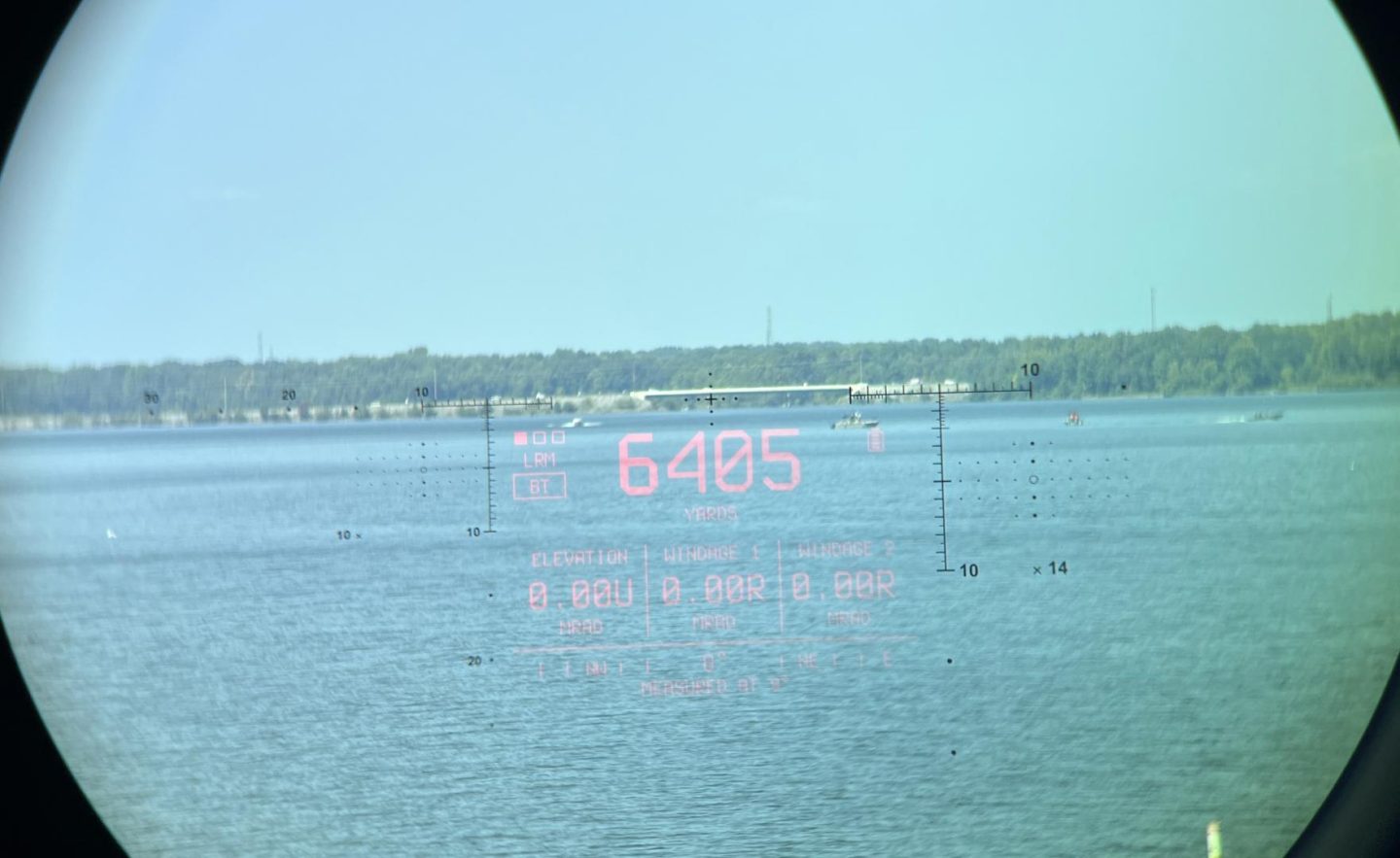
The second Vector X declare is 3,000 yards on bushes. That is fairly straightforward for the Vector X binos. In truth, I’ve returned readings nearer to 4,000 yards on tree strains on scorching shiny sunny days. 3,000 yards on bushes is way nearer to a worst situation state of affairs than to a greatest case one for the Vector X. Beneath these identical circumstances and on the identical targets, the Sig 10k carried out basically the identical because the Vector x. Since this tree line surrounds an enormous reservoir in such a means that it exists equally at just about any relevant vary, I used to be in a position to be very exact on this comparability. The Vector X and Sig 10k’s topped out inside 100 yards of one another making this goal kind in these circumstances probably the most related efficiency comparability for the 2 binoculars. These tree testing days had been late within the testing course of as effectively. So, the Vector X had been utilizing the freshest firmware at the moment. For reference, the Leica Geovid Professional 32’s high out at about 1,850 on bushes in direct daylight.
On what I’d have thought an analogous goal, grassy hillsides, each opponents lag their tree ranging numbers. When focusing on hillsides, on a unique cloudless, scorching day. The Sig topped out at 2,000 yards whereas the Vector X was in a position to get 2,750 admittedly with loads of phantom ranges alongside the way in which. This distinction in efficiency was probably the most dramatic I’ve seen and was additionally on the earliest firmware with which phantom ranges had been additionally fairly frequent for the Vector X. Nonetheless, more often than not the Vector X appears to nonetheless have a bonus over the Sig 10k on hillsides in very sunny, and scorching climate. This benefit is much less pronounced on the later software program however it’s nonetheless current and phantom ranges are fairly uncommon now even with the engineering pattern FPGA in my unit.
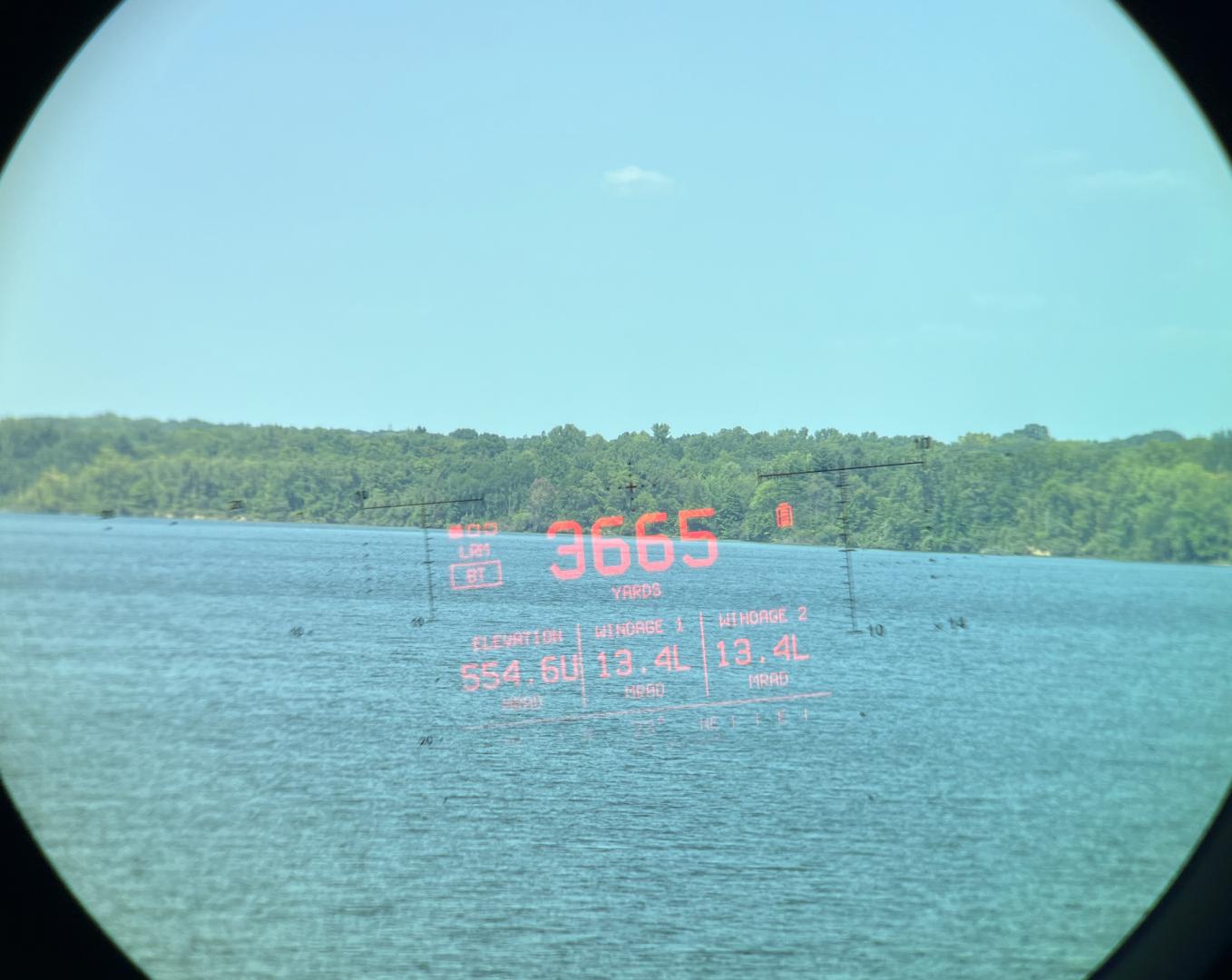
Vectronix final declare on rangefinding efficiency, and probably the most troublesome to check, is 2,400 yards on deer. I may give you 1,962 on a bison. Is that shut sufficient? What I can say is that furry dwelling critters have typically confirmed simpler to vary than equal sized bushes. That being stated, they’re smaller and, as they get additional away, you ultimately get to the purpose that extra of the beam passes round them than truly hits them and sign processing will get extra complicated. For what it’s price, 2,400 yards on a deer doesn’t strike me as notably difficult for the Vector X binos and its efficiency on dwelling fleshy targets was equal to that of the Sig 10k’s on the entire mammalian targets I used to be in a position to take a look at each binos on. It’s possible that variations do exist between these two however ranging dwelling issues is topic to them being there and being seen and knowledge factors are subsequently restricted sufficient that the gaps between them are bigger than the variations between these binoculars.
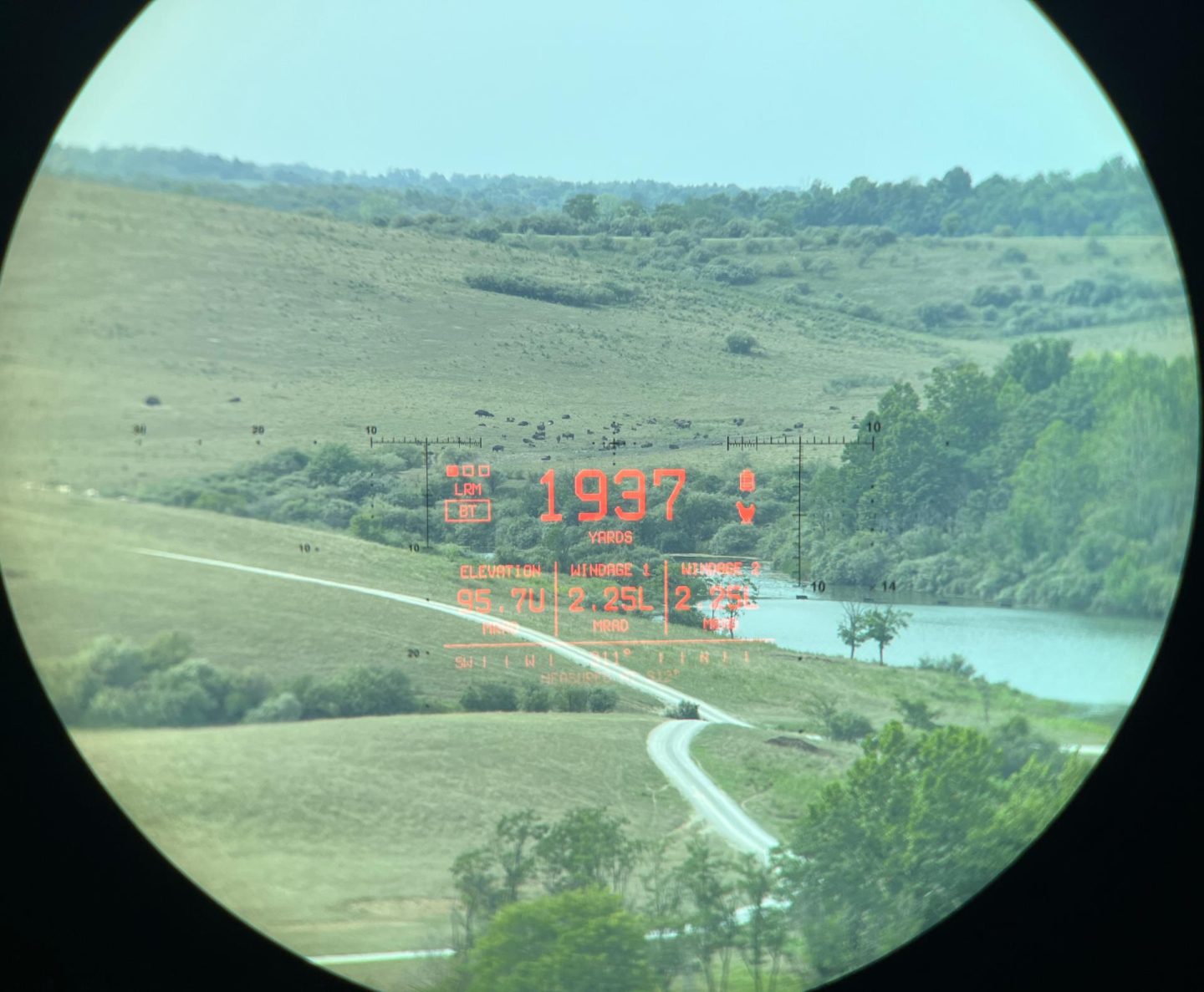
One final word on the Vector X laser efficiency. The Vector X solely has three “goal” or “laser” modes. These are mainly lengthy vary, a common greatest goal kind mode, and a restricted length steady scan mode that’s truly the Vector X’s highest efficiency mode and is initiated by holding down the ranging button. They don’t have a primary goal, final goal, or any specialty mode like fog / snow. With lasers beams being as tight as they now are I’ve not usually discovered most of those modes to be very helpful and I can inform you the Vector X ranges effectively in fog or driving rain. Although it’s a minor consideration, I’ve discovered fog mode to be one thing of a miracle employee on the Sig 10k’s in heavy snow. I clearly haven’t used that mode a lot, however it was loopy spectacular once I did.
Different Onboard Sensors:
As with different laser rangefinding binoculars, the Vector X comes with a set of different sensors along with the rangefinding laser. There may be an atmospheric strain sensor, temperature sensor, humidity sensor, angle of inclination sensor, and a compass. Sooner or later, additionally, you will have the choice of including the wi-fi Calypso AB version ultrasonic wind meter. Among the enchantment of an all-in-one rangefinder and ballistic solver is that every one these sensors will be routinely built-in into the calculations for higher accuracy, pace, and translatability from wherever you zeroed the rifle and practiced to wherever you’re looking. To do that although, the sensors need to be fairly correct. I’ve subsequently examined them with a level of rigor consistent with how correct they should be to suit their perform. That’s to say, I examined them to verify they had been ballpark sufficient as a result of they don’t need to be tremendous near be adequate for the ballistic calculation. I examined the temperature sensor on a number of events and located that it was inside 5 or so levels of the native climate knowledge. As with most such sensors it acclimates slowly and is topic to error if the gadget heats up from direct solar publicity. As such, Vectronix provides you an choice to lock in a handbook temp or seize one from an area climate station. The atmospheric strain sensor shouldn’t be about that can assist you predict and oncoming storm entrance however appeared to be inside about 1inHG. This interprets to roughly 1,000 or so toes or so of elevation. Additionally, not notably helpful in predicting the climate is the humidity sensor. This sensor additionally has solely a small impact on the ballistics and it doesn’t seem like notably correct saying issues like 59% humidity an hour after rain when the native climate station reviews the extra anticipated 90% worth.
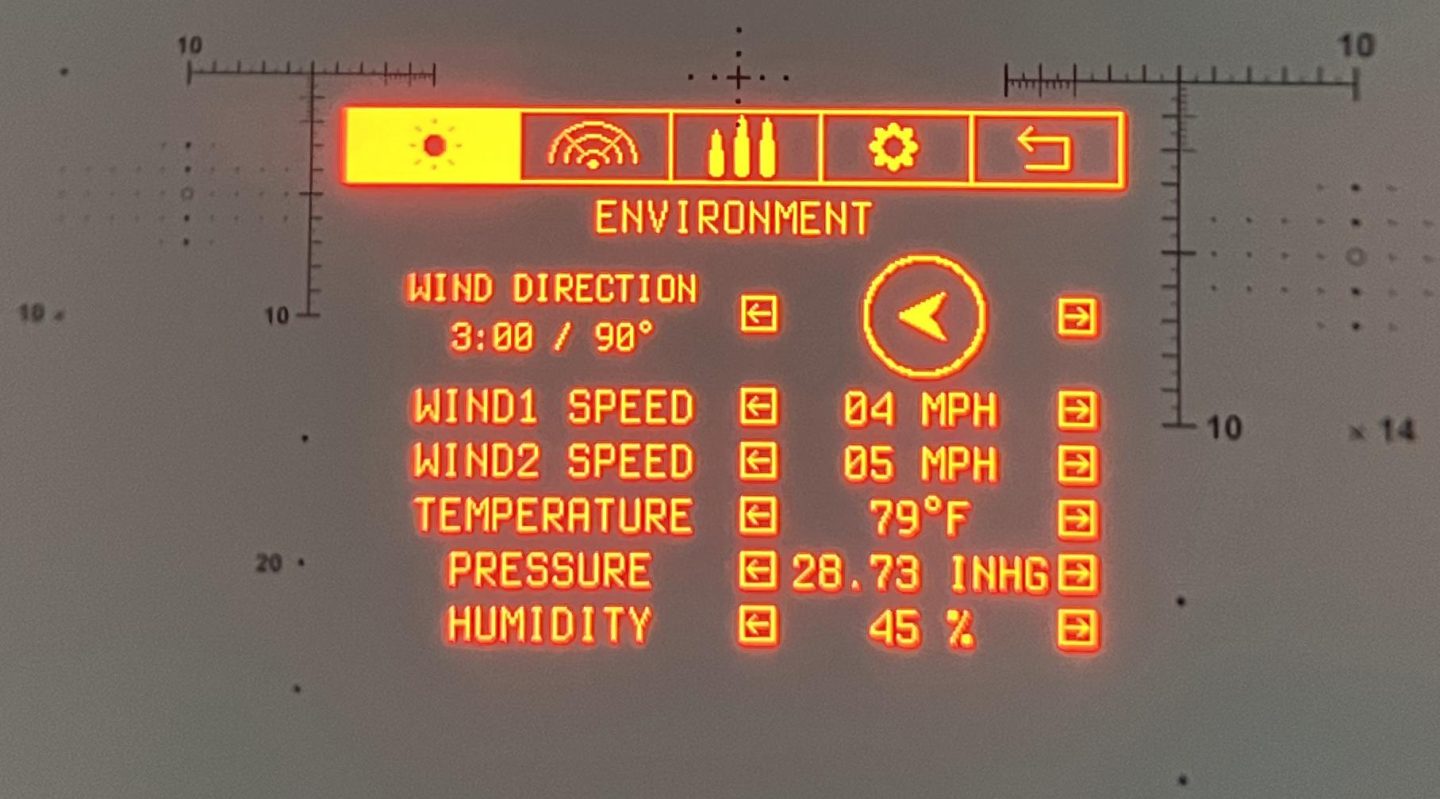
The Vector X’s even have an angle of inclination sensor. This has been fairly spot on when examined. They have to not have trusted it an excessive amount of although because the surveying ranging mode current within the beta software program that was closely reliant on it has disappeared from the reside model. That is too unhealthy. It was a enjoyable device to play with that had not less than leisure worth.
Lastly, we’ll discuss concerning the always-finicky magnetic compass. Within the Vector X, as in most LRF binos, this stuff are chip sized and really delicate to small electromagnetic disturbances surrounding them. The Vector X binos are distinctive in that they’re mainly always working a compass calibration and conserving tabs on how effectively they suppose they know which means they’re pointing. In the event that they suppose they’re poorly calibrated, they immediate you to do a step of rotations outlined within the handbook by exhibiting a rooster dance icon within the higher proper of the HUD. That is due to the humorous similarities between the motions of somebody doing the rooster dance and somebody doing a compass calibration. All of my testing was finished when no such icon was prompting. Nevertheless, the handbook was not printed on the time of my testing and so I didn’t comply with precisely it’s set of steps. I slowly rotated and flipped the binoculars as previous makers have prompted me to do till the rooster was pleased and left me alone. In any case, the compass perform in LRF binos has little impact on ballistics because the impact in calculates, Coriolis, is a remarkably small impact at small arms distances. Not small is the compass impact on the distant level GPS maping options that hunter’s discover fairly helpful in finding a place to begin for a blood path to recuperate harvested animals. Extra on this will likely be present in each the smartphone software part as Vectronix has a superb in-app monitoring perform. The Vector X handbook lists the Azimuth accuracy of the compass at +-5 levels. Maybe that’s true of the chip in correct lab settings however within the discipline it was not. Many of the compass diversified extra like +-10 levels for a sequence of measurements that may themselves be heart on +- 10 levels from the precise azimuth which means that the proper heading might or might not lie inside a diffusion of readings and a person studying might be so far as 20 levels from the precise heading. That is just like the Gen 1 Sig 10k’s compass efficiency and about twice as inaccurate because the Gen 2 models or the Leica Geovid Professional. I discovered this lackluster efficiency shocking as Vectronix has the most effective in-app monitoring perform of the three I anticipated its fixed calibration rooster dance factor to ship higher outcomes than it did.
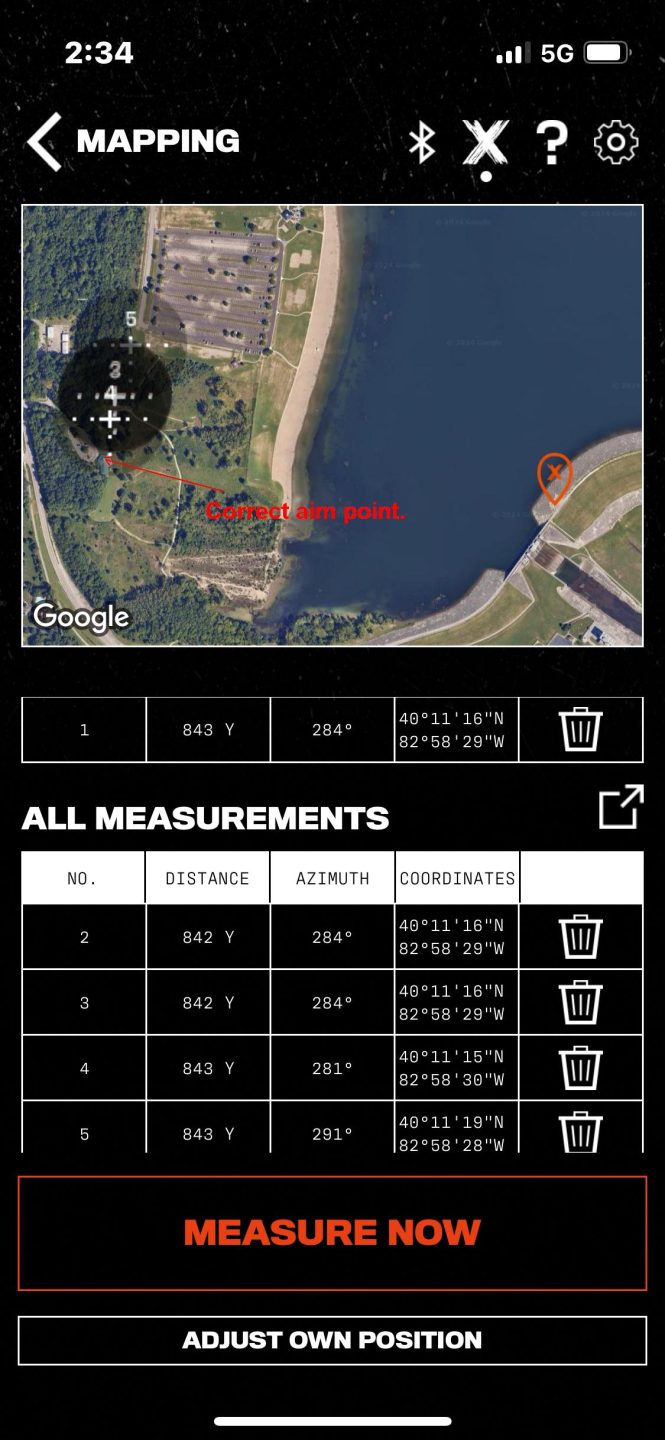
The Smartphone App(s)
I’ve now had the chance to check 4 completely different flavors of the Utilized Ballistics smartphone app. For probably the most half, these are completely different re-skins of the identical underlying code. The Utilized ballistics calculation engine, gadget interface protocols, and ballistic library don’t change primarily based on what software is getting used and, as such, when I’ve discovered bugs in this system prior to now, these bugs have typically, although not at all times, spanned a number of completely different corporations’ purposes. That being stated, the person interfaces of the 4 AB purposes I’ve tried have some main variations and you’re tied to the one which corresponds with the precise maker of your gadget. As such, the app is a crucial a part of the gadget shopping for determination and, in my judgment, the Vectronix software is the most effective of the bunch.
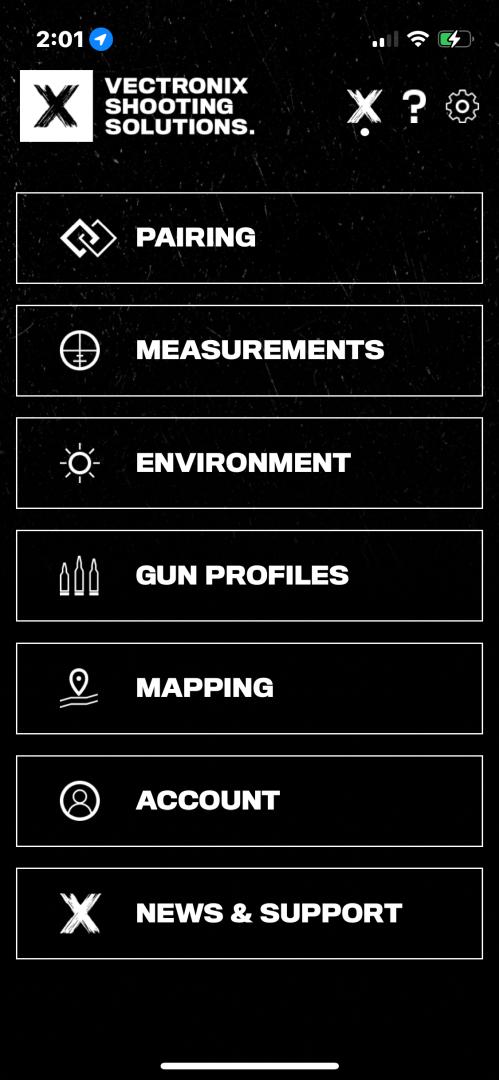
My judgment of its superiority, is because of a mix of higher and extra intuitive group, extra options, and fewer restrictions on how and when options are used. The group of the VECSS app begins out with the primary perform you’ll ever use, paring, proper on the high. It then proceeds to measurements, the one you’ll use most, surroundings, possible the subsequent most, and on down within the order I’d anticipate. The sub menus are additionally effectively organized and intuitive to navigate. Particular options, similar to truing a profile, will not be locked into use solely whereas actively ranging, and I didn’t encounter any restrictions on truing distance that may intervene with truing a slower cartridge on the relevant distances. The VECSS app was additionally not always prompting me to attach my rangefinder to make use of elite options at any time when I used to be messing with a profile so there’s possible a 30day timer on this verification perform as is the case on the Leica as a substitute of the requirement to attach each session as with the Sig. That’s good as I don’t need to need to dig rangefinders out of the secure to spitball stuff with the ballistic calculator on my telephone. The VECSS app even has the good function of permitting you so as to add footage to your ballistic profiles so you possibly can drop in a picture of the rifle or maybe the relevant ammo field. It’s not world altering, however it positive appears to be like good.
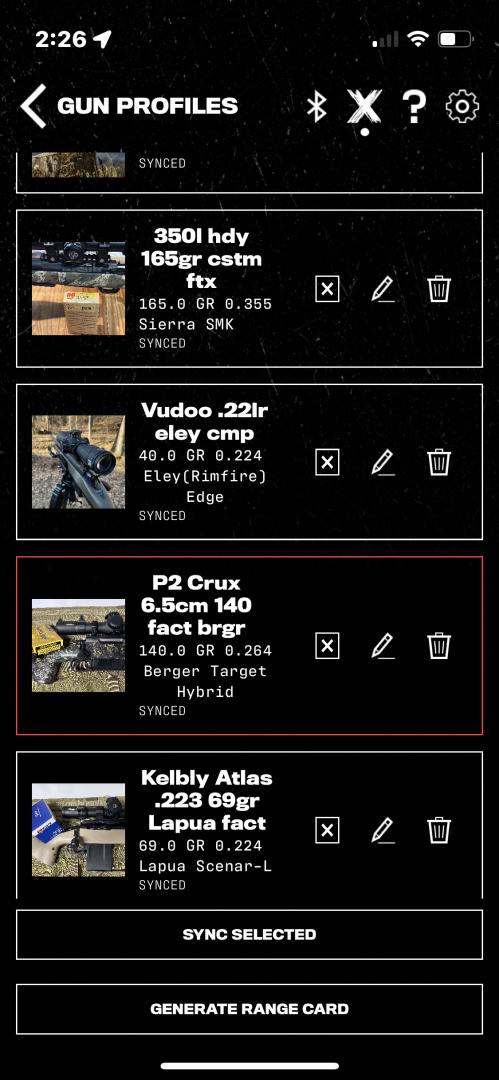
I feel the lively vary discovering display on the telephone will likely be judged as notably helpful by the competitors crowd. It has a timer pop up on the underside that covers simply the underside environmental part of the display permitting you to vary targets whereas seeing the time. The rangefinding display additionally has a shortcut to the goal card perform.
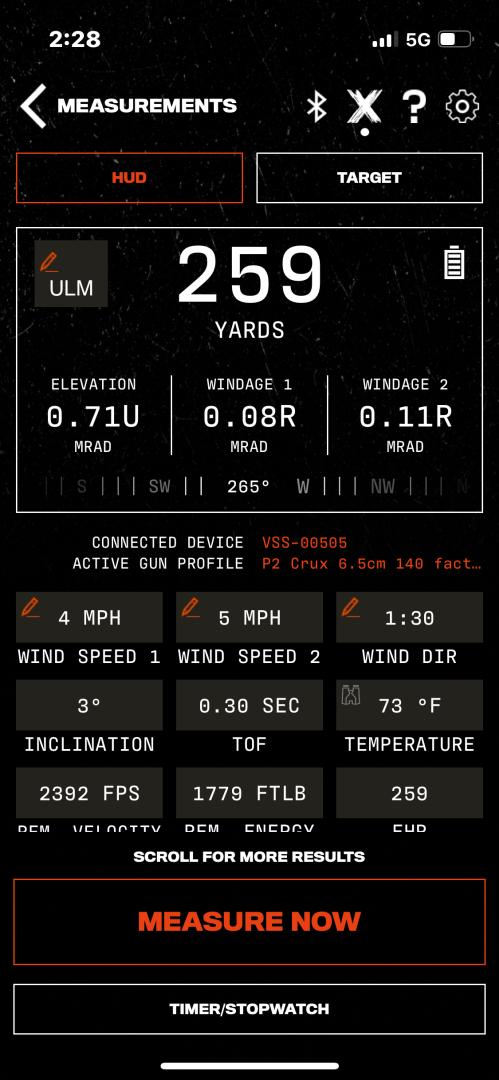
This brings us to the principle new options VECSS brings to the desk. These are a spread card created instantly with measurement knowledge and a GPS mapping distant level function constructed instantly into the VECSS software. That concentrate on card button within the app’s most important ranging display is one in all two methods you possibly can enter targets into the goal card by actively ranging them. You are able to do this from that concentrate on card tab within the smartphone app ranging menu or by using the binos shortcut of holding down the appropriate D-pad key whereas the binos are on their most important ranging display to enter the goal card creation display within the binos. Targets added in both means present up on each gadgets goal playing cards. It’s also my understanding the goal card may even be capable of be transferred to an E-DOPE card when this connectivity is added on the finish of this yr.
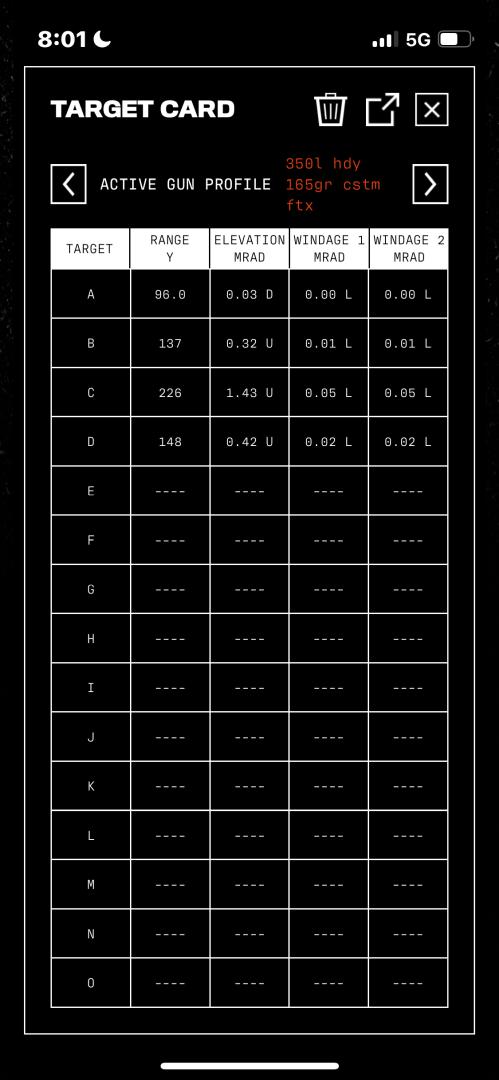
The second main function VECSS brings to the desk is full in-app integration of the distant level maping perform. This brings the Google map proper into the VECSS software and saves and shows the final 5 ranged factors in addition to your location. Most different rangefinders have as a substitute had an export-ranged level perform that then transferees you out of the appliance to Google, Apple, or onX. Alternately you can vary from inside one other app similar to BaseMap. Having the perform instantly within the VECSS app is good. For these questioning, I did strive maping in an space with no cell service. The purpose ranged, and your present location will present up however they won’t be on a map, only a clean background. Technically, this might nonetheless be used to navigate you to the purpose, you simply gained’t see any overhead view of surrounding options to assist you.
I’ll end up this part speaking a bit concerning the different gadgets and purposes that the Vector X can connect with. I’ve already talked about E-DOPE playing cards for goal card show and Calypso mannequin AB wind meters for wind measurement. The Vector X literature additionally mentions Kestrel models for wind and environmentals, quite a few Garmin watches, BaseMap, and Hornady 4DOF and Desert Tech Trasol for alternate ballistic calculations. A few of these gadget interfaces at the moment work, some are partially working, and a few don’t but have performance however are slated to by the tip of the yr. As an illustration, on the time of writing, Hornady 4DOF, Desert Tech Trasol, and the Calypso AB gadget don’t but interface with the Vector X or VECSS software. I’ve examined these, however I don’t have quite a few the opposite gadgets to check. I perceive that connectivity is in various states of completion for these gadgets.
Vary Enhancers and different aftermarket equipment
The thread on 40% magnification boosters referred to as the “vary enhancers” that Vectronix designed for the Vector X binoculars are probably an important aftermarket accent and I anticipate that almost all customers will possible be buying them. Because of manufacturing delays, they are going to be accessible in November or December. The magazine boosters are so central to the design of the Vector X that the preferred reticle design, the DMR, has half of its measurement grid calibrated to be used with the magazine boosters connected. Connected, the magazine boosters convert the 8x Vector X binos to 11x, the 10x to 14x, and the 12x to 17x. The concept of that is that, in live performance with the barrel mounted tripod interface, this converts the Vector X or Radical X binoculars right into a twin eye recognizing scope substitute for recognizing and calling a companions shot. Utilizing excessive powered binoculars for this objective has change into a well-liked apply as having each eyes on a shot yields a greater skill to obviously spot the influence and / or hint and that is judged by most opponents as superior to the upper magnification current in conventional recognizing scopes. Attending to this magnification by way of thread on magazine boosters as a substitute of natively provides the binoculars the flexibility to both be used with magazine boosters connected on a tripod as spotters or with out as handheld as discipline binoculars at a magnification manageable for that much less secure place.
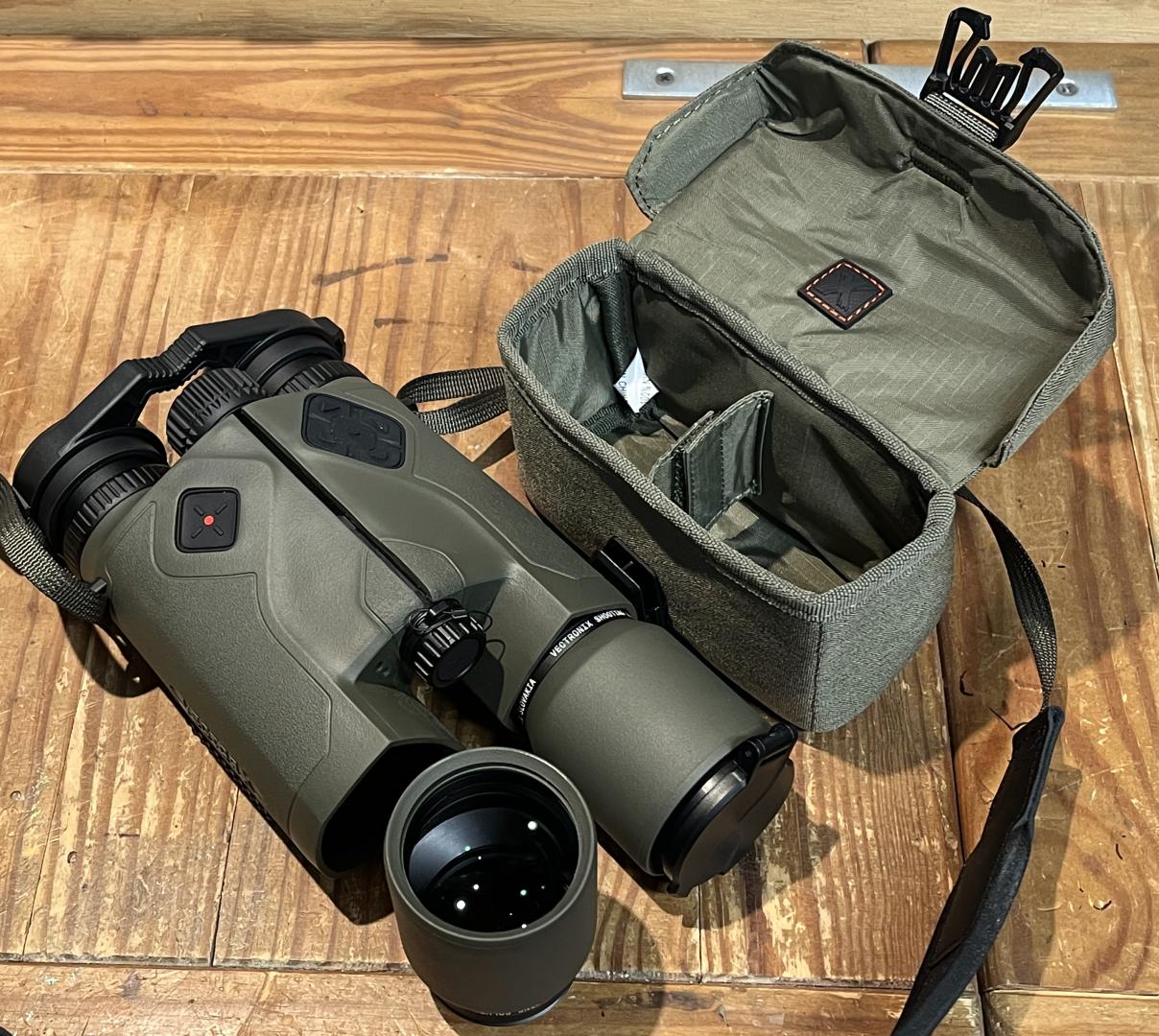
Bodily, the magazine boosters are about 2.75” lengthy and thread to the entrance of the binoculars utilizing very positive M46x.75 threads. The threads are very positive and consequently troublesome to place good to get began. Watch out and affected person on this operation. The magazine boosters can be utilized in live performance with the included goal flip caps however not the thread on Tenebraex ARD as they don’t have threading on each ends. Once I examined the magazine boosters optically, I discovered them wonderful. They had been in a position to resolve take a look at targets correctly scaled for the upper magnification on the identical decision because the native binoculars resolve the un-scaled goal. Additionally they didn’t add important chromatic aberration and didn’t significantly degrade edge to edge efficiency or add a bunch of pincushion or barrel distortion as I’ve seen prior to now with different related magazine boosting gadgets. That’s good, as they’re fairly expensive and, at that price, I’d anticipate good efficiency. So far as impact on laser efficiency, I didn’t word important adjustments to ranging efficiency in my testing with the magazine boosters connected. The Vector X binoculars do barely match within the carrying case with the boosters connected although I’d not suggest storing them connected as you’re making a useless air house that would foster condensation and mould development in that trapped air between the 2. The Magazine boosters ought to be indifferent for storage they usually have their very own good little case for the aim. My judgment is that the additional recognizing scope perform the magazine boosters present, not less than for the 10x and 12x fashions of Vector X is effectively definitely worth the substantial price. It’s a killer additional use configuration.
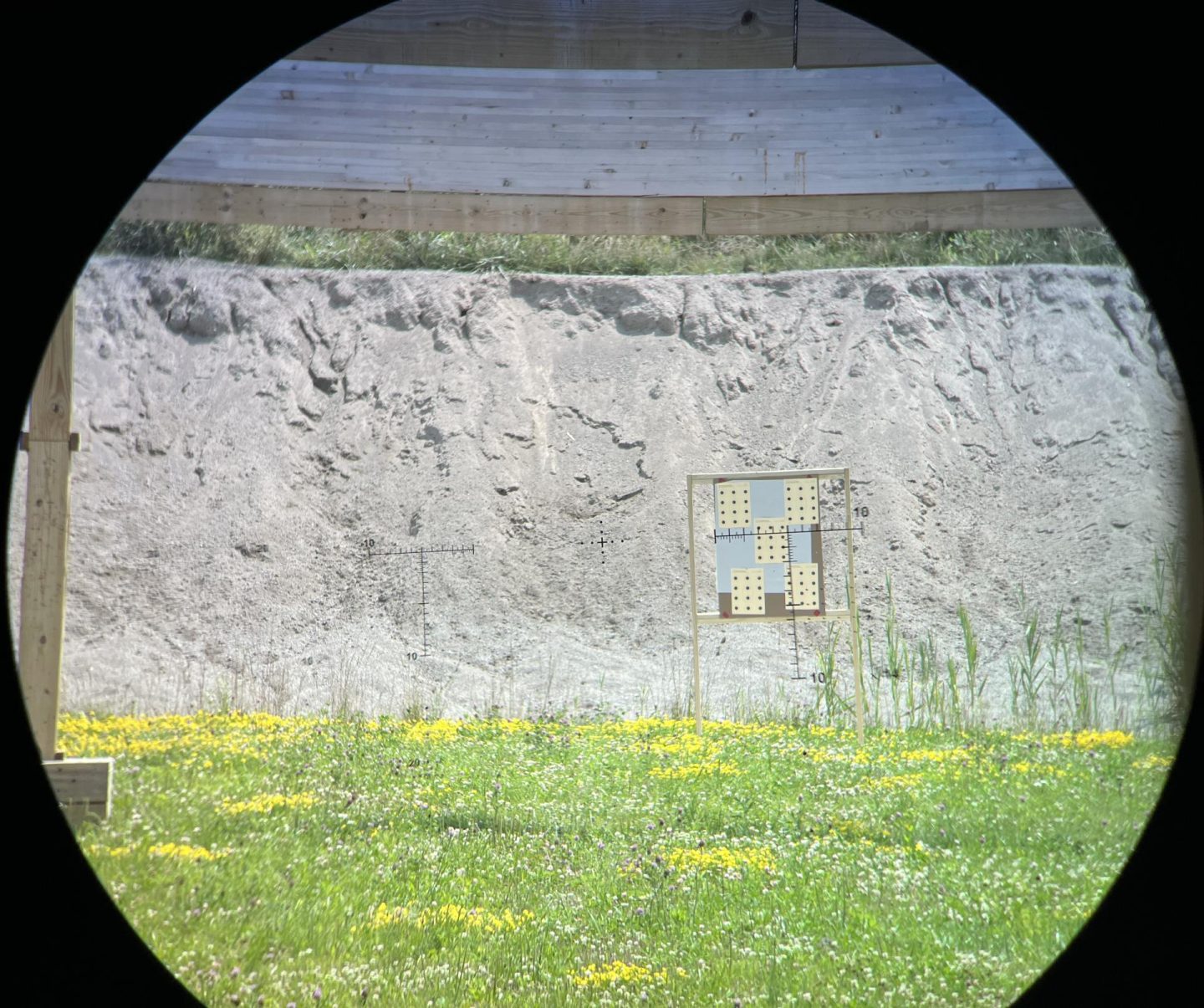
The second accent I want to speak about is the ARCA plates by RRS and Space 419. These mounts change the little plastic 1/4×20 tripod adapter included with each the Vector X and Radical X binoculars with full ARCA plates. Each of those are aluminum and thread instantly into the magnesium most important tube with 4 very small machine screws in the identical means the included manufacturing facility mount does. The RRS ARCA adapter has a cant adjustment in-built to be used with video type tripod heads that don’t have cant adjustment. Its most important draw back is that the cant adjustment protrudes into the realm the place your thumb grips the binos making them much less snug for one hand use. The Space 419 model has no such adjustment and subsequently lays a bit flatter, doesn’t intervene along with your thumb grip in your proper hand, and prices much less. In apply, these ARCA plates are a bit much less snug for holding the binoculars than the decrease profile manufacturing facility mount or no mount (an possibility as there’s an included plastic cowl for the mounting space.) Nevertheless, they supply a really regular mounting level that’s rather more stable than a conventional binoculars bridge mount and far decrease in profile than strapping on a cinch mount. After all, each the RRA and Space 419 mounts are manufactured to very excessive requirements as similar to these two producers’ merchandise are well-known for.
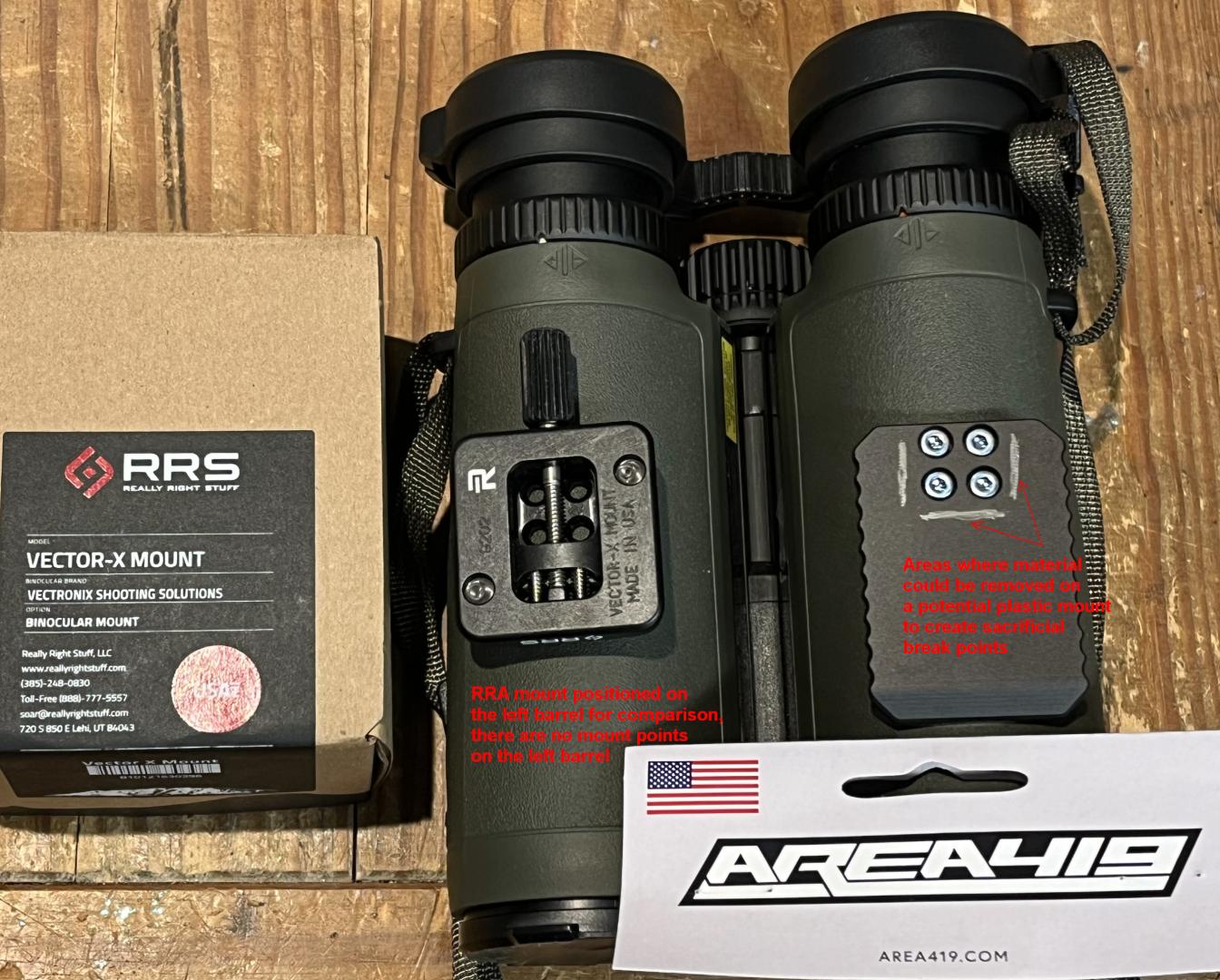
My concern for each these ARCA mounts is that they’re each fairly strong and linked to a relatively fragile magnesium most important tube by rigid metal machine screws. I’m involved the binoculars might be broken at this attachment level throughout a tripod fall or maybe even when the person torques on the binoculars to lever a too tight tripod head into place within the method you typically place a stiff tripod head when taking pictures off it utilizing your rifle as a lever. I caught myself absent-mindedly doing this greater than as soon as when utilizing the binoculars and was horrified to understand how a lot drive I used to be making use of to such small screws into magnesium on a $3k binocular. Different customers have variously steered buying nylon replacements for the included metal screws or just utilizing a cinch mount as with different binos. Relying on the failure level, the nylon fastners may work effectively or, they may break off within the bino after saving it and be troublesome to take away. The cinch is clearly a confirmed system although a bit cumbersome and a few have crushed binocular tubes by over tightening them as effectively. Ideally, I feel an ARCA mount ought to be made for the Vector X from a stiff, brittle plastic with in-built calibrated sacrificial failure factors such that the mount would break as a substitute of the binoculars within the occasion of an over-torque occasion. All of that is, after all, hypothesis. In apply the mount works fairly effectively, it simply strikes me as a dangerous design.
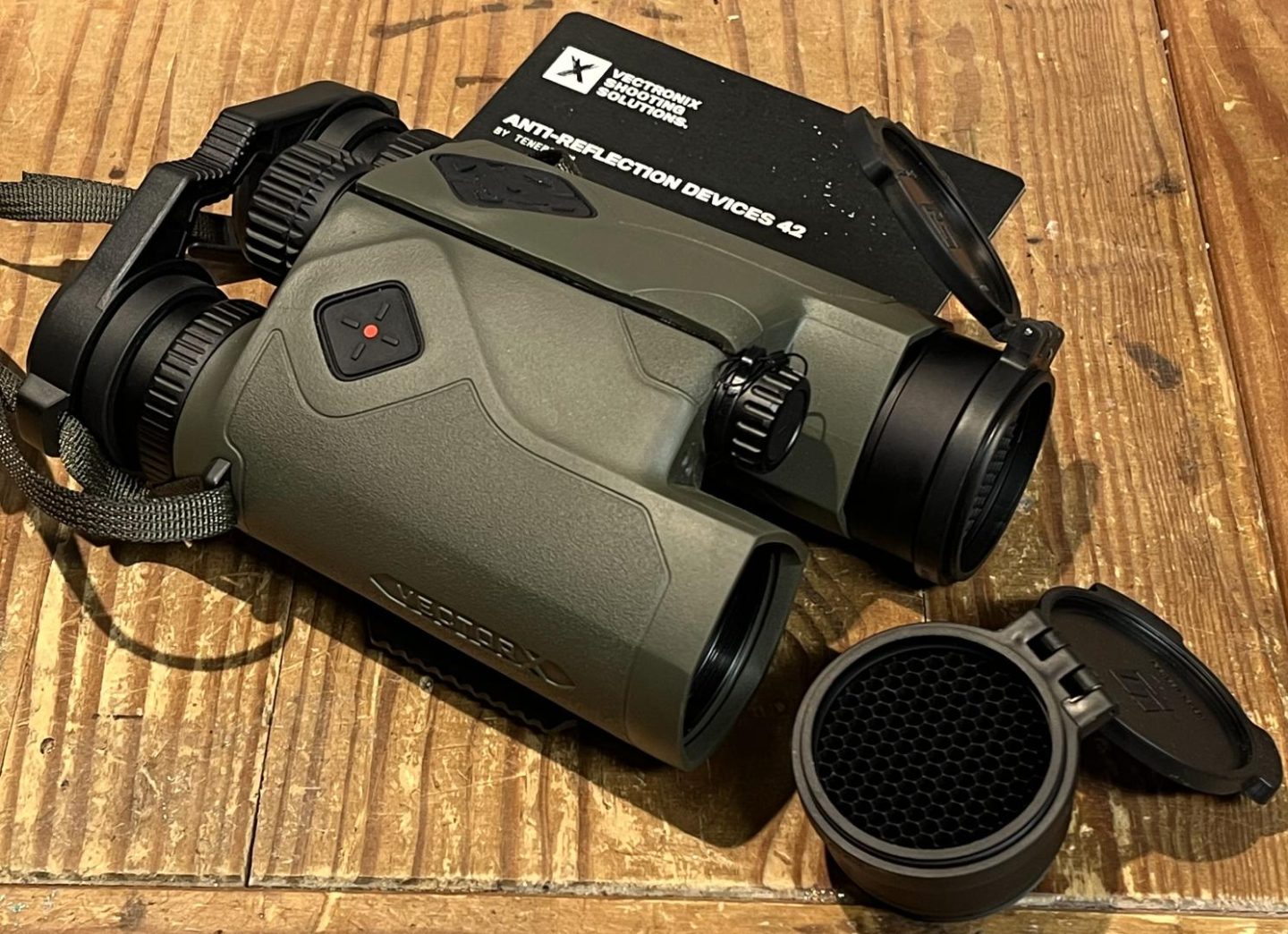
The final launch day accent to be mentioned is the Tenebraex ARD flip caps. These carry the huge price ticket you in all probability anticipate from Tenebraex. In truth, regardless of containing no optics, they’re nearly as costly because the magazine boosters. The ARDs thread onto the Vector X binos utilizing the identical M46x .75 threads because the magazine boosters and the plastic flip elements of the cap have a stiff, listed interface with the aluminum portion that permits them to be rotated to flip the path you need and keep in that orientation. Additionally they latch securely sufficient that they won’t inadvertently flip open (or pop off for that matter) when eradicating the binos from the case because the manufacturing facility flip covers do. Past testing the fundamental ranging perform with them, I’ll admit I didn’t spend sufficient time testing on their impact on rangefinding efficiency to notice any variations. Vectronix assertion on the matter is that you will note decreased most ranging efficiency when utilizing the ARD. I anticipate this too be most dramatic within the lowest mild and subsequently most very best rangefinding circumstances. Notably, these are additionally the circumstances by which an ARD is of the least use. I anticipate when utilizing the ARD, you may see an enchancment within the binoculars’ optical efficiency in circumstances the place daylight would in any other case instantly strike the target lens of the binoculars. Sunshades and ARDs at all times enhance optical efficiency in such circumstances and generally fairly dramatically. The Vector X binoculars match of their case with the ARD connected fairly simply. The underside line is that the Tenebraex ARDs are very effectively executed, a bit cumbersome to placed on and take off in case your commonly if you happen to swap them out for the magazine boosters, and embarrassingly pricey. , like all Tenebraex merchandise.
Abstract and Conclusion:
There isn’t a doubt that the Vectronix Vector X is a feature-laden product. It combines binoculars, a rangefinder, a recognizing scope (with vary enhancers), and a ballistic calculator multi function. The implementations of many of those options such because the onboard Utilized Ballistics Elite and the 304×256 pixel AMOLED are high of the road options. It additionally encompasses a notably strong slated ecosystem of supported linked equipment and software program although, on the time of launch, a lot of this isn’t but on-line.

The most important shock to me in testing the Vector X is that its optical efficiency is on par with Leica Geovid professional binoculars making the Vector X a high tier rangefinding product by way of optical efficiency. The glass is downright wonderful and never diminished although the addition of the 40% magnification boosters that, when connected, rework the Vector X into a superb recognizing scope substitute. When the twin magnification DMR reticle is chosen, that recognizing perform features a second etched graduated reticle to work in live performance with the magnification boosted binoculars providing you with a correctly graduated reticle each for when you’re and whenever you aren’t utilizing the magnification boosters. This provides the binoculars wonderful twin competitors and looking cross-over use.

Additional facilitating that competitors use is a twin in-bino / in-app goal card system that permits the person to rapidly create a goal card by actively ranging the goal and have that card sync between the binoculars and the appliance with functionality to even be shared with a third occasion E-DOPE card. There may be likewise a timer perform each within the telephone software and within the binoculars. Total, these options, a greater and extra intuitive app format, and in-app full distant level gps performance make Vectronix model of the Utilized Ballistics software my favourite of the various flavors I’ve tried.
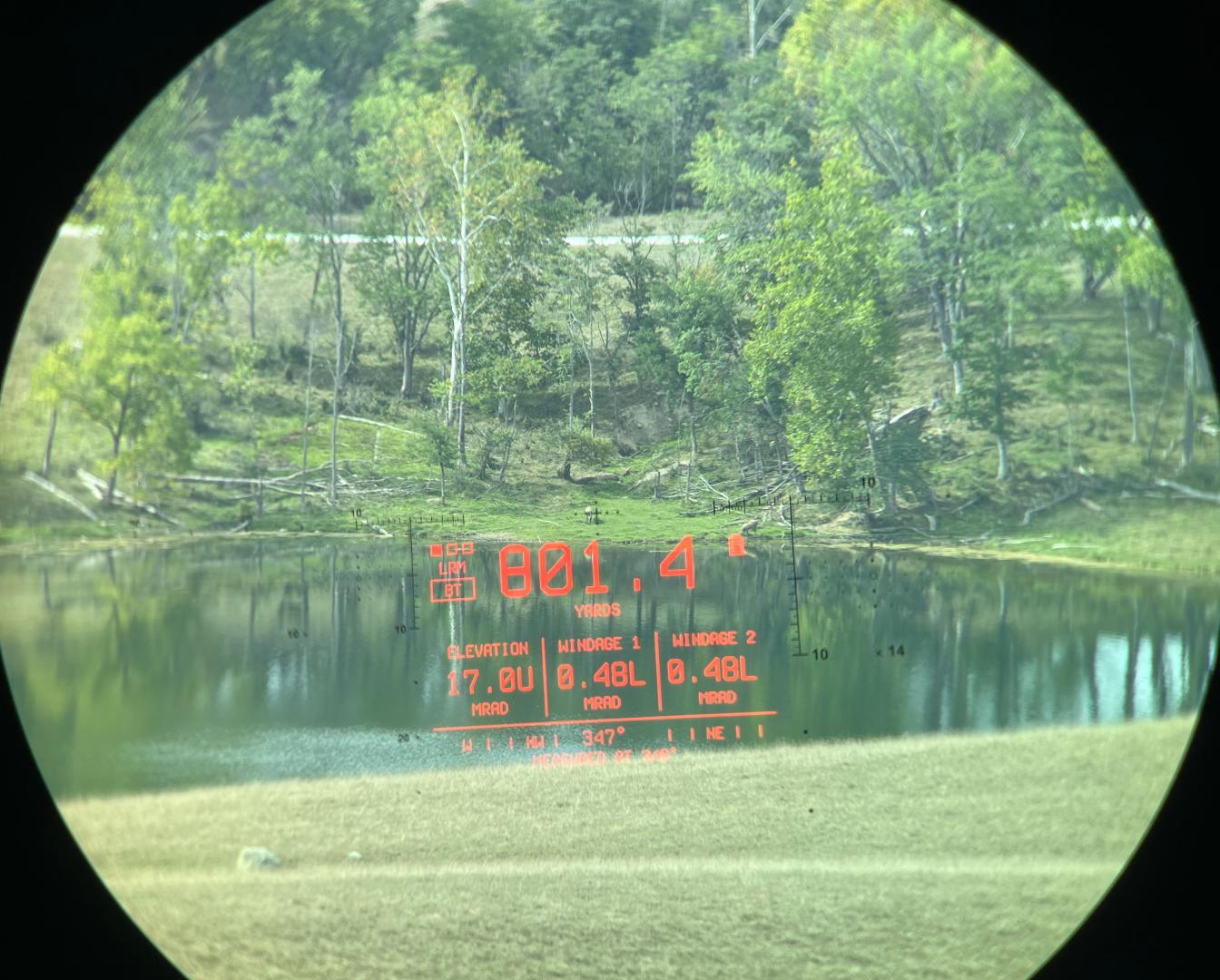
In vary discovering efficiency the Vector X is the primary eyesafe 905nm product to problem the Sig Kilo10k-ABS in rangefinding efficiency. Provided that I’m reviewing an engineering pattern not similar to the business ones in firmware and that the Vector X and Kilo 10k traded the efficiency crown backwards and forwards relying on the vary circumstances, I’d not say one outperformed the opposite however that they’re comparable and that, collectively, they characterize the highest tier in laser efficiency for eysafe 905nm merchandise.
I’d like to say that the guarantee protection matches the remainder of the efficiency of the Vectronix Vector X. Nevertheless, at solely 3 years on electronics and 10 years on glass it massively lags the limitless lifetime guarantee of Sig and Vortex on their rangefinders and the ten yr electronics with 30 yr optics guarantee the Leica Geovid Professional 32s carry. Vectronix additionally doesn’t have a very good historic fame for guarantee service or for restore ease and availability exterior of the guarantee. Their fame did enhance some with the Terrapin X a number of years again however I nonetheless wouldn’t have characterised it as nice. The launch of the brand new shopper division that the Vector X and Radical X releases coincide with ought to additional that enchancment. As with the Terrapin X, guarantee service for these merchandise is being dealt with via Europtic, the U.S. distributer and importer for all Vectronix merchandise. They’ve some minor elements readily available for restore. Additionally they have trade models that may be supplied to the shopper in occasion of emergency as extra severe repairs will necessitate the unit being despatched over the pond to be labored on by Vectronix. I spoke with the oldsters at Vectronix about persevering with service after the ten yr guarantee expires. They plan to supply this although possible at a value for the buyer.
Background on Ballistics Calculation, Modeling, and Utilized Ballistics Elite
This, and the next different background sections, comprise background and technical info relevant to quite a lot of laser rangefinding merchandise. They don’t seem to be particularly relevant to the merchandise of anybody firm and could also be present in quite a lot of evaluations for merchandise within the class.
For a very long time, ballistics calculators have just about all used the identical underlying math, which is actually primarily based on the measured trajectories of two primary examined projectiles, these being the G1 and G7.

Every software program would iterate from these underlying measured trajectories utilizing a comparability issue referred to as the Ballistic Coefficient. This coefficient established a comparative diploma of aerodynamics between the shooter’s particular bullet and the G1 or G7 normal, in line with which the system would stretch and deform the unique G1 or G7 measured trajectory to be extra like what can be anticipated from the person’s bullet. That is the place the G1 and G7 BC numbers in your bullet field come from and what they imply.

In apply, the everyday course of utilizing G1 or G7 primarily based software program was to measure the speed of your rifle when establishing your 100 yd zero or when growing a brand new handload to your rifle, then plug that worth together with the BC on the field and your atmospherics into your software program to get an preliminary set of ballistic options for various distances. These would after all be improper by a number of tenths of a mil or in order you bought additional out. You’d write down the actual field-recorded values after which fudge with the BC and / or velocity till the mannequin being spit out was as near right as you can get it. This new mannequin can be useful in spitting out good numbers for various untested distances or on days with completely different atmospheric circumstances. It wouldn’t be excellent and, with all of the guessing and checking, it might take some time to get to, however it might be useful.
After all, the mannequin confronted some limitations as a result of your bullet shouldn’t be truly formed like both the G1 or G7 normal. Its trajectory is essentially not only a G1 or G7 trajectory stretched a bit. Moreover, you’re firing it from a gun a bit completely different from regardless of the take a look at gun was in these unique trajectory research, at a unique preliminary velocity. All this issues. The underside line is that there’s a restrict to how precisely you possibly can stretch the G1 or G7 trajectories primarily based on only a BC quantity and preliminary velocity quantity, and that restrict is inferior to many people would really like it.
Due to this, a few corporations have begun measuring the trajectories of extra projectiles from extra rifles fired at extra velocities. That is the origin of Utilized Ballistics’ Customized Drag Fashions (CDM) and Hornaday’s Bullet-Particular Drag Fashions. Software program primarily based on these libraries, similar to Utilized Ballistics Elite, can output higher distance compensation values than that which relies on G1 and G7 values as a result of the underlying trajectory curves are these of the particular bullet in query. For extra element on these adjustments in ballistic calculation, Cal Zant did a superb article on Bullet-Particular Drag Fashions and Frank did a pair interviews with Brian Litz and Emil Praslick for the On a regular basis Sniper podcast.
Moreover, the rangefinding software program inside business rangefinders has additionally shifted over time: first solely providing a number of inventory choices for preset ballistic curves; then permitting you to enter your individual G1 or G7 primarily based ballistic profile that you just needed to, by guess and examine, true to your precise discipline outcomes; and now beginning with a customized drag mannequin and having a truing perform throughout the software program that eliminates the tedious guess and examine truing. When utilizing software program with a truing perform, you merely enter a number of of your discipline outcomes for recorded drop at a identified distance and the software program positive tunes the customized drag mannequin, usually its preliminary velocity, to suit your knowledge.
Having spend a great deal of time with Utilized Ballistics Customized Drag Fashions during the last two years I’m very impressed with the advance this engine affords over conventional G1 and G7 fashions in addition to what number of bullets have been added to the CDM library and the way commonly it’s up to date. You’ll now discover mainly something utilized in lengthy vary competitions in addition to fairly quite a few looking bullets. Had been speaking loads of bullets, 447 on the time of writing for six.5mm alone as an example. My expertise is that these customized fashions are considerably higher out of the gate than conventional fashions to the purpose that (assuming you realize your muzzle velocity) they incessantly require no truing to be right all the way in which out to transonic distance. Within the occasion that you just do have to true the speed, that is rather more simply completed although the truing perform within the software program than by conventional guessing after which re-testing as was finished in earlier calculators. The top end result trued up mannequin can be typically higher than was produced utilizing older G1 and G7 software program as I typically beforehand produced fashions that may be off by a tenth mil or so at far and I used to be unable to treatment this with MV or BC adjustments to the system with out messing up another a part of the curve. This software program has enormously improved my confidence in my knowledge when interpolating or extrapolating to distances I’ve not particularly gathered dope on or in circumstances completely different from which I gathered the dope in (the LRF binos in query collect knowledge on and compensate for temperature and strain). I’m lacking quite a bit fewer targets, spending quite a bit much less time crunching numbers, and chasing my tail quite a bit much less in miss evaluation as effectively.
Background on How Laser Rangefinders Work
As with most instruments in life, a greater understanding of the ideas behind, and idiosyncrasies of, the device’s perform typically leads to extra skillful use and higher outcomes. The aim of this part is to assist familiarize the reader with simply what a laser rangefinder truly sees and the way it analyzes and conveys this info to the person.
Although quite a lot of strategies can be utilized to evaluate distances utilizing lasers, the vast majority of laser rangefinders, together with this one, make use of a time-based calculation for distance. What this implies is that the heart beat is distributed out and bounces again, after which the time between these two occasions is used to calculate the gap. That is straightforward sufficient in precept. In apply, nevertheless, we’re not speaking about one laser pulse however many, and quite a lot of different components additionally complicate this, so the ensuing knowledge requires some interpretation. Crucial of those components are beam dispersion, refraction, and background radiation.
Beam dispersion refers to the truth that the form of a beam being emitted from the vary finder is a cone, with the extensive base oriented to the goal, and never a rod. That’s, the beam spreads out and covers extra space the additional the article being ranged is from the rangefinder. As well as, most rangefinders, this one included, emit a beam that isn’t spherical in cross part, however relatively nearer to rectangular.
Within the case of this specific rangefinder, the divergence is .06 mils within the vertical by 1.5 mils within the horizontal. The Sig Kilo 10ks are distinctive in offering the person the flexibility to align this beam to the reticle manually throughout the BDX smartphone app. It’s important that you just do that as it’s unlikely will probably be ideally aligned out of the field, simply as it’s unlikely most different rangefinders may have a wonderfully aligned beam. The distinction is that you may align the 10k your self whereas most others you simply need to make a psychological word on the alignment and reside with it. For many makers, a go for beam alignment on QC means solely that some portion of the beam touches some portion of the reticle, not that it’s correctly centered. Certainly, when examined, the beam on this 10k was simply barely touching the sting of this reticle. To heart it utilizing the alignment perform throughout the BDX software program, an adjustment of -4 within the horizontal and +1 within the vertical was crucial. With the ability to do that is a lot appreciated, as a small misalignment can matter an ideal deal when ranging small objects distant. In figuring out your alignment, you possibly can fairly simply see the beam with a nightvision system, because the rangefinder’s 905nm beam is within the spectrum the nightvision sees. Nevertheless, if you happen to don’t have nightvision, as I don’t, there are a few methods to determine the alignment. The simplest might be to discover a good, flat, small signal roughly the scale of your reticle when its a pair hundred yards away and see how far proper, left, above, and beneath, you possibly can intention and nonetheless get the vary of the signal. I did this with the beneath pictured rectangular industrial mild and adjusted the beam increment by increment throughout the BDX software program to heart it. Keep in mind, you possibly can flip the binos upside-down or sideways throughout testing to make certain to not get returns from the submit whenever you’re looking for the underside fringe of your beam. Additionally of word when adjusting the reticle alignment on the 10ks, is that you just deal with the ranging throughout the program throughout the course of and never from the binoculars vary button.
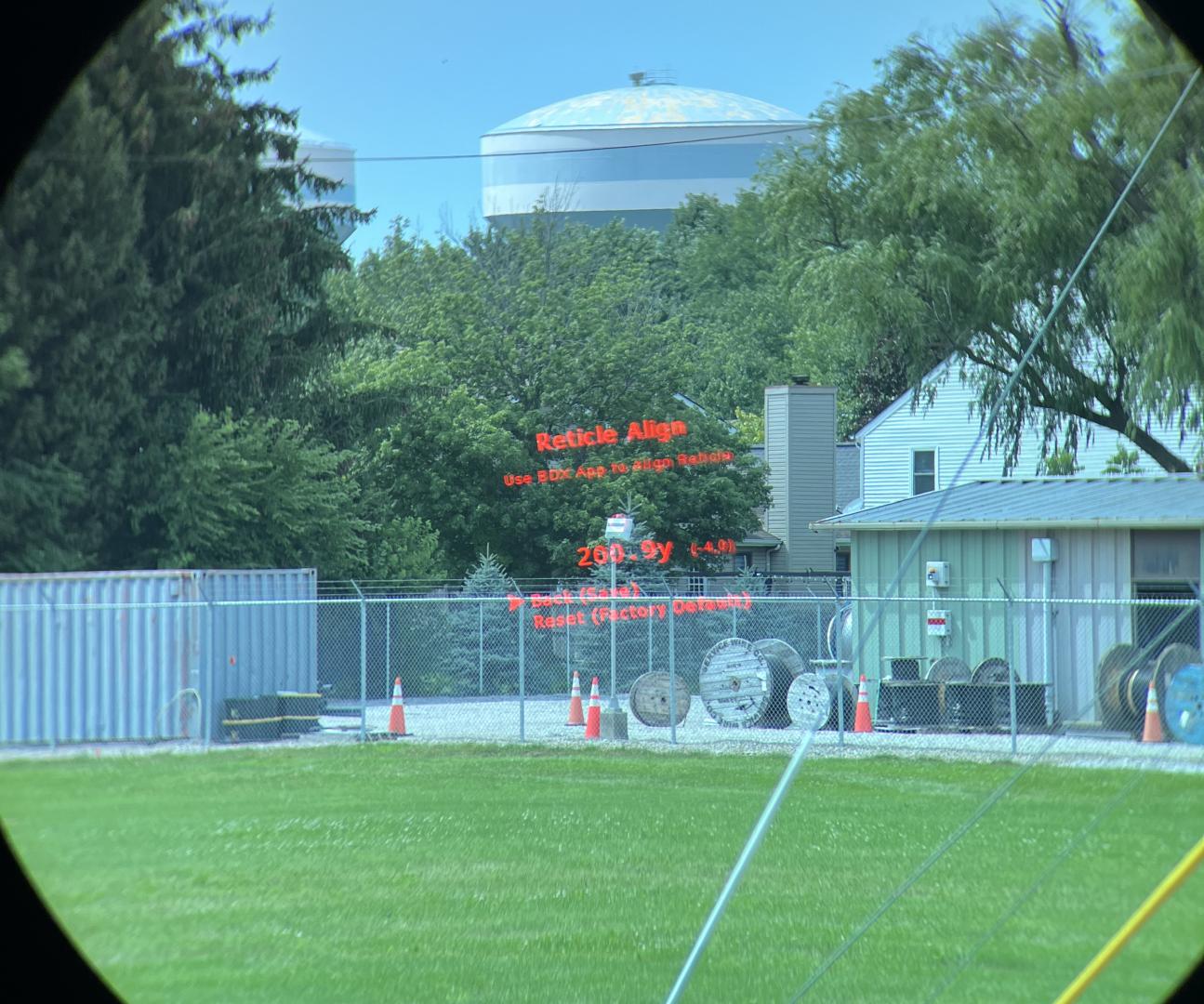
Along with alignment, it is usually vital to grasp simply how giant a laser rangefinder beam will get at longer ranges. Presently, common beam dispersion for a laser rangefinder is one thing like 2 x 1 mils. That is 7.2″ extensive at 100 yards, or 72″ at 1000 yards. With this sample, in case you are attempting to vary a goal at 1000 yards, except it’s an elephant, a lot of that beam will likely be reflecting again from what’s round and behind the quarry and never the animal or, extra possible at that vary, metal itself. More often than not, a rangefinder might obtain a sign comprised principally of sunshine not mirrored off of the goal. Information evaluation will subsequently be crucial to select the goal out from what shouldn’t be goal. Comparable in impact to this, many targets will not be completely flat and perpendicular to the rangefinder. As a result of the beam is broad on the goal finish, which means what’s mirrored again is not going to be a single sharp sign however quite a few completely different reflections at quite a few completely different distances. For those who intention at a hillside, as an example, some will likely be mirrored off the nearer backside of the hillside, some off the additional high, and a few off every little thing in-between. A tree may even give a broad studying as it’s a three-dimensional object with reflective elements and items all through. What the rangefinder truly sees, subsequently, is to not be represented as a single blip at a single distance, however relatively a plot of many returns at many distances with quite a lot of peaks and valleys akin to distances at which a number of (valleys) or many (peaks) of the laser pulses had been mirrored again. The rangefinder might perform all of the interpretation of this plot itself or it might permit the person some extent of management. In principle, a rangefinder may additionally current all the plot to the person for interpretation, although I’m not conscious of any fashions that do that. This Sig 10k, with its pixel-based show, is without doubt one of the few that theoretically may, although it doesn’t. It does, nevertheless, provide you with a considerable amount of selection in knowledge evaluation. The rangefinder’s menu contains modes for final (favor far goal), first (favor close to goal), greatest (goal with greatest returns), XR (favor furthest goal and extra ranging pulses will likely be despatched out over an extended time), and fog (completely different processing algorithm to reduce misguided returns.) That’s a great deal of selection, and given the wonderful menu system of the 10ks, it’s straightforward to entry and make the most of this perform.
Refraction refers back to the bending of sunshine via mediums of differing density similar to air or water. The heart beat despatched out by a rangefinder should journey although a substantial amount of medium earlier than returning. This air may have quite a lot of completely different temperatures and moisture contents. It might additionally comprise microscopic or macroscopic water droplets. All of this, in addition to mud within the air, will serve to scatter or soak up the laser such that a lot of the beam will both not hit the goal or not return. The impact of it will change into extra pronounced with distance on the identical time that beam dispersion dictates that the beam is extra unfold out with distance. This works collectively such that the additional an object is, the much less sign may probably be mirrored off of it. At some vary, subsequently, the sign is not going to be robust sufficient to be distinguished from the final of your vital components. Moreover, in case your rangefinder is of the upper energy 1500nm selection as a substitute of the extra frequent 900nm selection (these Sig 10k binos use a 905nm laser), absorption and scattering change into a a lot greater deal. 1500nm lasers work together closely with water and so change into far much less efficient the extra water is within the air.
Background radiation is omnipresent however varies enormously with atmospheric circumstances. At night time, if you happen to may see the goal to vary it, you wouldn’t have a lot of an issue. On a shiny day, nevertheless, the solar is introducing an amazing quantity of electromagnetic radiation that’s reflecting, refracting, transferring power to things, and being radiated as soon as once more at completely different wavelengths. A few of this cacophony of radiation will likely be shut sufficient to the wavelength utilized by the rangefinder to be picked up. This radiation will type a flooring to the attainable sign energy returned from the article ranged that might be learn.
I’ve made the next crude diagram of what the person, and the rangefinder, may see in a selected contrived state of affairs with a purpose to assist the reader to grasp the kind of knowledge a rangefinder is perhaps decoding. This isn’t strictly correct because the rangefinder doesn’t ship one beam out and document a bunch of various returns however relatively sends out a complete bunch of tiny pulses and data a return for every. In different phrases, the theoretical return plot I present is way smoother than precise knowledge would look, although the form is similar. I feel this fashion of depiction is most helpful in serving to the person to grasp what a rangefinder sees, although. It might additionally assist the person, the place attainable, to current the rangefinder with situations the place it might need a better name to make. In different phrases, to intention to get higher returns,generally, by ranging easier-to-read objects close to in proximity and distance to a small, desired goal as a substitute of that concentrate on itself.
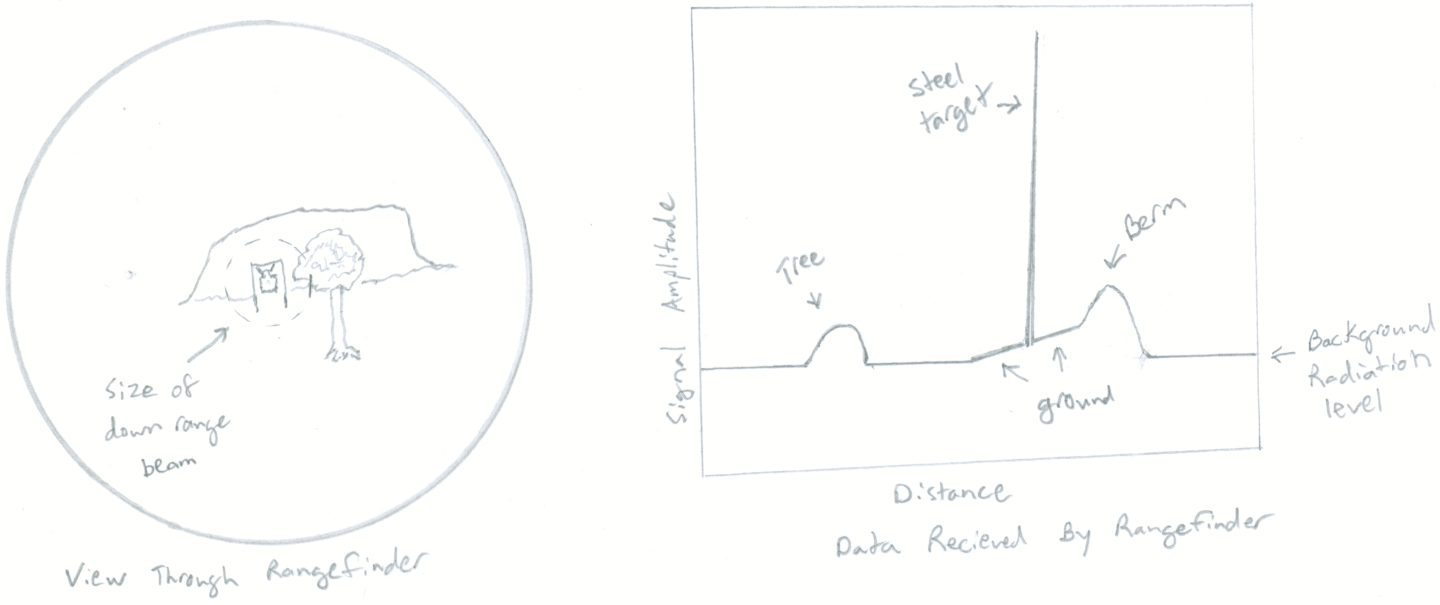
As you examine the above diagram and plot, remember the next attainable methods by which the info is perhaps interpreted by the rangefinder and the way these interpretations would impact the person not solely on this instance state of affairs, the place the metal goal is the specified object to be ranged, however in different situations as effectively: maybe when ranging softer targets towards exhausting or absent backgrounds.
1) A rangefinder is perhaps programmed to show the closest peak in amplitude to the person. This is able to be the tree.
2) A rangefinder is perhaps programmed to show the furthest peak in amplitude. This is able to be the berm.
3) A rangefinder is perhaps programmed to select the height with the best space beneath. This usually corresponds to the article filling the best space of the diverged laser beam down vary. On this instance, this is able to be the berm.
4) A rangefinder is perhaps programmed to select the height with biggest most amplitude. This normally corresponds to any object that’s sufficiently giant, reflective, and principally perpendicular to the shooter. On this case, that’s the metal goal.
Most rangefinders are programmed to select one in all these standards to find out the vary from. A couple of have a number of modes you possibly can change between. These usually help you set desire for close to / first goal (tree), far / final goal (berm), or highest variety of sign returns / greatest goal (berm or metal relying on particular standards). The Sig 10ks have modes for every of those and these modes are simply discovered within the binoculars menu system beneath “Goal Mode”.
Background on the Challenges of Getting Optical Efficiency from a LRF Bino:
Producing laser rangefinding binoculars of excessive optical high quality is a troublesome proposition. Nonetheless, this can be a essential space of efficiency as a result of the concept of LRF binos isn’t just to exchange a small rangefinding monocular, but additionally to exchange the binos you utilize to seek out and observe your quarry. For such objective, LRF binos want quite a bit higher optics than the small, darkish, closely tinted view you get via a bit handheld LRF monocular unit.
Amongst the difficulties confronted in designing optically excessive performing LRF binos, foremost are the impact of the show on optical efficiency and the right way to combine the laser optic elements with these for seen mild. You could have some robust choices to make in the case of coatings because the laser transmitter and receiver are a part of the optical system, in the appropriate barrel. The laser wavelength used, 905nm, is simply exterior of the seen mild spectrum. This laser mild should each go via and make the most of a lot of the optical system used for the seen mild touring to the person’s eyes and be diverted from the remainder of the incoming mild at some extent to be redirected to a receiver positioned within the barrel. Clearly, this can be a coatings problem.
The opposite most important optical problem of laser rangefinding binos is the impact of the show on optical efficiency. There may be merely no option to put a show shiny sufficient to see within the optical path with out some diminution of transmittance. Moreover, to an ideal extent, there’s a direct tradeoff between how shiny you can also make the show and what % of incoming mild the binoculars can transmit to your eye. For those who’re keen to have a picture via the binoculars that’s dimmer, or, say, blue-tinted, your show will be fairly shiny. If you need the picture shiny and untinted, nevertheless, you will have to go together with much less show brightness and possibly less complicated, bigger, illuminated digits. The rationale for that is that your show mainly works by bouncing the show picture off a lens in the principle optical path. This requires some semi-reflective coating, as on a holosight or pink dot. These coatings soak up mild and the extra you need them to mirror the sunshine in entrance of them (for a brighter show) the extra they soak up the sunshine behind them (what you’re taking a look at via the binoculars). The problem of sunshine absorption of this nature is robust sufficient that two of the makers of optically superior laser rangefinding binoculars have opted for uncommon selections in prism design, partially to counter the sunshine loss. Leica, on its Geovid sequence, has gone with a Perger-Porro prism design, whereas Zeiss went with an Abbe-Koenig prism system. Each of those selections provide extra mild transmission and are far much less frequent than the Schmidt-Pechan prisms most frequently merely referred to as roof prisms which can be present in most binoculars, together with the Sig 10ks, Vectronix Vector X, and Swarovski EL ranges.
Background GPS Mapping with BaseMap:
With this technology of laser rangefinders, Sig and some different makers have launched the flexibility to mark the situation of a ranged level utilizing BaseMap GPS software program. This function requires the paid subscription Professional model of the software program, at the moment going for $39 a yr.
The most important aim of distant marking is to assist the hunter to seek out the beginning of a blood path. Usually, after an animal is shot, it typically goes far earlier than it dies. As a result of animals don’t perceive what being shot represents, they don’t normally go far if they aren’t actively chased as a result of they neither perceive they’re dying nor that they’re being hunted. They simply really feel damage, then weak and drained. As such, after delivering a shot, hunters usually lay low and wait some time to begin monitoring the animal so that it’s going to not going go far earlier than bedding down and dying. It’s subsequently fairly useful to have an correct level to begin your seek for a path however this isn’t really easy when the sport begins 500yds from you and you need to wait some time earlier than beginning to observe it. Issues can look quite a bit completely different standing in a discipline than taking a look at that discipline from 500yds. It may be exhausting to seek out your place to begin, and that’s the most important thought behind dropping a distant GPS level on it.
Previous to doing this yr’s rangefinder evaluations, I had not noodled with the BaseMap software program in any respect. I had heard of it from individuals utilizing its satellite tv for pc map to estimate ranges to targets by mentioning a map of the vary and dropping factors on the map the place it thought the targets had been, however I hadn’t truly tried it. I discovered it a slick software program package deal and have used it quite a few instances not together with testing rangefinders. It has plenty of performance round creating routes, measuring distances, and marking campsites, gear drops, and different vital factors. BaseMaps can be designed for use with out entry to a mobile phone sign. This is a crucial consideration, on condition that the places having the most effective looking and mountaineering not often provide cell service. This additionally provides the Sig Kilo 10k, and different makers’ merchandise that interface with BaseMaps, the benefit of working with out cell service, whereas Swarovski’s related function makes use of its personal proprietary software program which requires a cell sign. Most significantly from the standpoint of my use, BaseMaps interfaced fairly simply with the Sig binos.
Inside BaseMap, mapping factors whereas ranging them is discovered throughout the BaseMap software program beneath instruments and is known as “Distant Marker”. Upon getting paired your binos to the software program, hitting this perform will immediate you to vary what you need to mark. While you vary, the purpose will present up in your map with a line from the place you’re standing to the ranged level. You possibly can then select to position a marker at that time, manually alter the marked level’s location, or simply dump the purpose. The software program makes use of three knowledge inputs to determine the place the purpose ought to go. These are the person’s location as decided by your telephone’s GPS, the gap and angle of the purpose from the person decided by the binos, and the Azimuth of the binoculars, decided by the compass within the binos. The accuracy of first couple of inputs are typically fairly good. Usually, exterior the GPS is sweet to inside about 3yds, the vary inside 2yds, and the inclination inside a level and a half or so. In my testing, nevertheless, the Azimuth was solely good inside 20 levels or so. This interprets into numerous error because the distances improve and boy can these Sig Kilo 10ks vary a good distance.
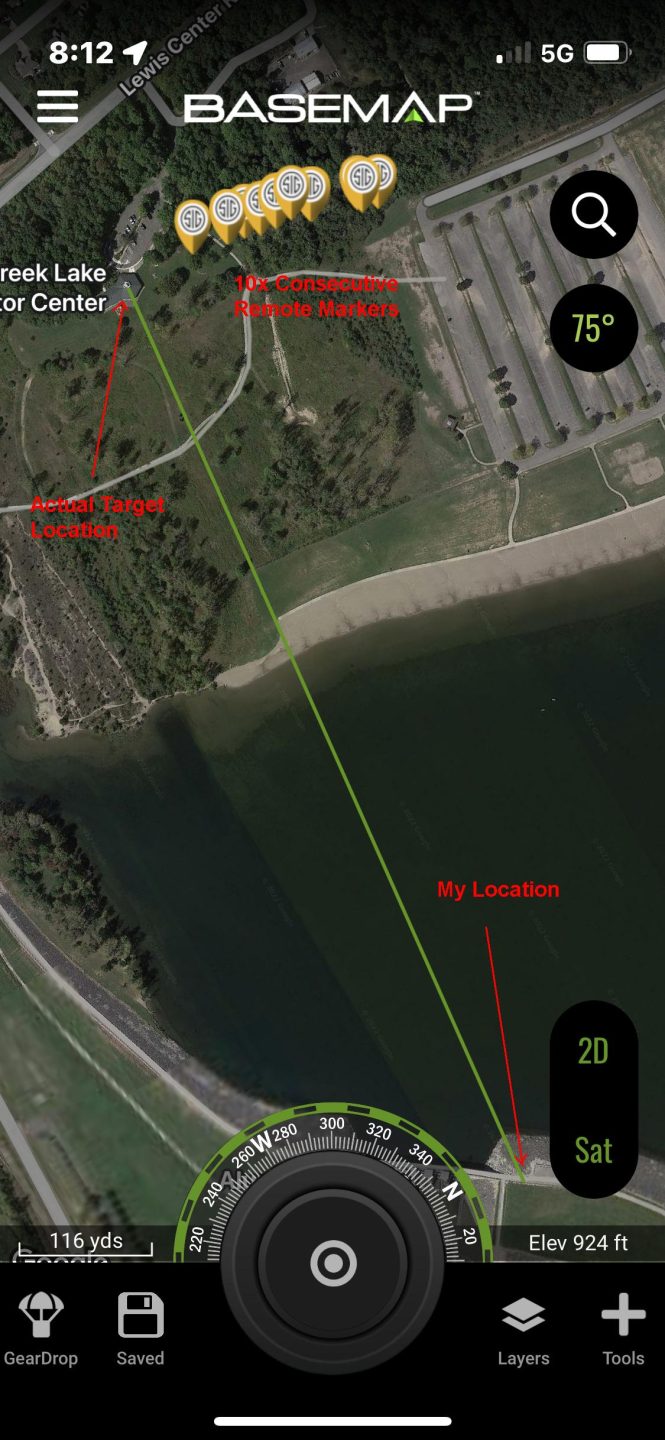
Thankfully, this isn’t a random error and we aren’t speaking about an space of uncertainty as a lot as a path of uncertainty. There may be little or no uncertainty in both the person’s beginning location or the gap of the goal from the person. Due to this fact, you possibly can fairly simply mark out an arc-shaped path of chance and simply stroll it from one finish to the opposite. You are able to do this by ranging and marking the identical level 5-10 instances. All these factors will line up on a gently arcing path. Its no good, clear, single pinpoint, however it’s nonetheless an amazing support in serving to you discover the animal’s path. Remember the fact that once I did my testing of this function, greater than half the time the proper goal location didn’t truly lie throughout the bounds of the ten factors I dropped so when you’re following the arc made by the factors you dropped, you’ll possible want to increase previous the furthest level in every path with a purpose to attain the goal location you ranged. Frankly, the software program ought to in all probability simply mark an arc for you on the map as a substitute of a single level. This is able to prevent from having to mark the identical level 5-10 instances, and, I consider, that is what Swarovski truly did. The little chip-sized digital compasses in these and different competing binoculars simply aren’t very correct.





















